- Engineering Mathematics
- Discrete Mathematics
- Operating System
- Computer Networks
- Digital Logic and Design
- C Programming
- Data Structures
- Theory of Computation
- Compiler Design
- Computer Org and Architecture
- Computer Network Tutorial

Basics of Computer Network
- Basics of Computer Networking
- Introduction to basic Networking Terminology
- Goals of Networks
- Basic characteristics of Computer Networks
- Challenges of Computer Network
- Physical Components of Computer Network
Network Hardware and Software
- Types of Computer Networks
- LAN Full Form
- How to Set Up a LAN Network?
- MAN Full Form in Computer Networking
- MAN Full Form
- WAN Full Form
- Introduction of Internetworking
- Difference between Internet, Intranet and Extranet
- Protocol Hierarchies in Computer Network
- Network Devices (Hub, Repeater, Bridge, Switch, Router, Gateways and Brouter)
- Introduction of a Router
- Introduction of Gateways
- What is a network switch, and how does it work?
Network Topology
- Types of Network Topology
- Difference between Physical and Logical Topology
- What is OSI Model? - Layers of OSI Model
- Physical Layer in OSI Model
- Data Link Layer
- Session Layer in OSI model
Presentation Layer in OSI model
- Application Layer in OSI Model
- Protocol and Standard in Computer Networks
- Examples of Data Link Layer Protocols
- TCP/IP Model
- TCP/IP Ports and Its Applications
- What is Transmission Control Protocol (TCP)?
- TCP 3-Way Handshake Process
- Services and Segment structure in TCP
- TCP Connection Establishment
- TCP Connection Termination
- Fast Recovery Technique For Loss Recovery in TCP
- Difference Between OSI Model and TCP/IP Model
Medium Access Control
- MAC Full Form
- Channel Allocation Problem in Computer Network
- Multiple Access Protocols in Computer Network
- Carrier Sense Multiple Access (CSMA)
- Collision Detection in CSMA/CD
- Controlled Access Protocols in Computer Network
SLIDING WINDOW PROTOCOLS
- Stop and Wait ARQ
- Sliding Window Protocol | Set 3 (Selective Repeat)
- Piggybacking in Computer Networks
IP Addressing
- What is IPv4?
- What is IPv6?
- Introduction of Classful IP Addressing
- Classless Addressing in IP Addressing
- Classful Vs Classless Addressing
- Classless Inter Domain Routing (CIDR)
- Supernetting in Network Layer
- Introduction To Subnetting
- Difference between Subnetting and Supernetting
- Types of Routing
- Difference between Static and Dynamic Routing
- Unicast Routing - Link State Routing
- Distance Vector Routing (DVR) Protocol
- Fixed and Flooding Routing algorithms
- Introduction of Firewall in Computer Network
Congestion Control Algorithms
- Congestion Control in Computer Networks
- Congestion Control techniques in Computer Networks
- Computer Network | Leaky bucket algorithm
- TCP Congestion Control
Network Switching
- Circuit Switching in Computer Network
- Message switching techniques
- Packet Switching and Delays in Computer Network
- Differences Between Virtual Circuits and Datagram Networks
Application Layer:DNS
- Domain Name System (DNS) in Application Layer
- Details on DNS
- Introduction to Electronic Mail
- E-Mail Format
- World Wide Web (WWW)
- HTTP Full Form
- Streaming Stored Video
- What is a Content Distribution Network and how does it work?
CN Interview Quetions
- Top 50 Networking Interview Questions (2024)
- Top 50 TCP/IP interview questions and answers
- Top 50 IP addressing interview questions and answers
- Last Minute Notes - Computer Networks
- Computer Network - Cheat Sheet
- Network Layer
- Transport Layer
- Application Layer
Prerequisite : OSI Model
Introduction : Presentation Layer is the 6th layer in the Open System Interconnection (OSI) model. This layer is also known as Translation layer, as this layer serves as a data translator for the network. The data which this layer receives from the Application Layer is extracted and manipulated here as per the required format to transmit over the network. The main responsibility of this layer is to provide or define the data format and encryption. The presentation layer is also called as Syntax layer since it is responsible for maintaining the proper syntax of the data which it either receives or transmits to other layer(s).
Functions of Presentation Layer :
The presentation layer, being the 6th layer in the OSI model, performs several types of functions, which are described below-
- Presentation layer format and encrypts data to be sent across the network.
- This layer takes care that the data is sent in such a way that the receiver will understand the information (data) and will be able to use the data efficiently and effectively.
- This layer manages the abstract data structures and allows high-level data structures (example- banking records), which are to be defined or exchanged.
- This layer carries out the encryption at the transmitter and decryption at the receiver.
- This layer carries out data compression to reduce the bandwidth of the data to be transmitted (the primary goal of data compression is to reduce the number of bits which is to be transmitted).
- This layer is responsible for interoperability (ability of computers to exchange and make use of information) between encoding methods as different computers use different encoding methods.
- This layer basically deals with the presentation part of the data.
- Presentation layer, carries out the data compression (number of bits reduction while transmission), which in return improves the data throughput.
- This layer also deals with the issues of string representation.
- The presentation layer is also responsible for integrating all the formats into a standardized format for efficient and effective communication.
- This layer encodes the message from the user-dependent format to the common format and vice-versa for communication between dissimilar systems.
- This layer deals with the syntax and semantics of the messages.
- This layer also ensures that the messages which are to be presented to the upper as well as the lower layer should be standardized as well as in an accurate format too.
- Presentation layer is also responsible for translation, formatting, and delivery of information for processing or display.
- This layer also performs serialization (process of translating a data structure or an object into a format that can be stored or transmitted easily).
Features of Presentation Layer in the OSI model: Presentation layer, being the 6th layer in the OSI model, plays a vital role while communication is taking place between two devices in a network.
List of features which are provided by the presentation layer are:
- Presentation layer could apply certain sophisticated compression techniques, so fewer bytes of data are required to represent the information when it is sent over the network.
- If two or more devices are communicating over an encrypted connection, then this presentation layer is responsible for adding encryption on the sender’s end as well as the decoding the encryption on the receiver’s end so that it can represent the application layer with unencrypted, readable data.
- This layer formats and encrypts data to be sent over a network, providing freedom from compatibility problems.
- This presentation layer also negotiates the Transfer Syntax.
- This presentation layer is also responsible for compressing data it receives from the application layer before delivering it to the session layer (which is the 5th layer in the OSI model) and thus improves the speed as well as the efficiency of communication by minimizing the amount of the data to be transferred.
Working of Presentation Layer in the OSI model : Presentation layer in the OSI model, as a translator, converts the data sent by the application layer of the transmitting node into an acceptable and compatible data format based on the applicable network protocol and architecture. Upon arrival at the receiving computer, the presentation layer translates data into an acceptable format usable by the application layer. Basically, in other words, this layer takes care of any issues occurring when transmitted data must be viewed in a format different from the original format. Being the functional part of the OSI mode, the presentation layer performs a multitude (large number of) data conversion algorithms and character translation functions. Mainly, this layer is responsible for managing two network characteristics: protocol (set of rules) and architecture.
Presentation Layer Protocols : Presentation layer being the 6th layer, but the most important layer in the OSI model performs several types of functionalities, which makes sure that data which is being transferred or received should be accurate or clear to all the devices which are there in a closed network. Presentation Layer, for performing translations or other specified functions, needs to use certain protocols which are defined below –
- Apple Filing Protocol (AFP): Apple Filing Protocol is the proprietary network protocol (communications protocol) that offers services to macOS or the classic macOS. This is basically the network file control protocol specifically designed for Mac-based platforms.
- Lightweight Presentation Protocol (LPP): Lightweight Presentation Protocol is that protocol which is used to provide ISO presentation services on the top of TCP/IP based protocol stacks.
- NetWare Core Protocol (NCP): NetWare Core Protocol is the network protocol which is used to access file, print, directory, clock synchronization, messaging, remote command execution and other network service functions.
- Network Data Representation (NDR): Network Data Representation is basically the implementation of the presentation layer in the OSI model, which provides or defines various primitive data types, constructed data types and also several types of data representations.
- External Data Representation (XDR): External Data Representation (XDR) is the standard for the description and encoding of data. It is useful for transferring data between computer architectures and has been used to communicate data between very diverse machines. Converting from local representation to XDR is called encoding, whereas converting XDR into local representation is called decoding.
- Secure Socket Layer (SSL): The Secure Socket Layer protocol provides security to the data that is being transferred between the web browser and the server. SSL encrypts the link between a web server and a browser, which ensures that all data passed between them remains private and free from attacks.
Please Login to comment...
Similar reads.

Improve your Coding Skills with Practice
What kind of Experience do you want to share?
The OSI Model – The 7 Layers of Networking Explained in Plain English

This article explains the Open Systems Interconnection (OSI) model and the 7 layers of networking, in plain English.
The OSI model is a conceptual framework that is used to describe how a network functions. In plain English, the OSI model helped standardize the way computer systems send information to each other.
Learning networking is a bit like learning a language - there are lots of standards and then some exceptions. Therefore, it’s important to really understand that the OSI model is not a set of rules. It is a tool for understanding how networks function.
Once you learn the OSI model, you will be able to further understand and appreciate this glorious entity we call the Internet, as well as be able to troubleshoot networking issues with greater fluency and ease.
All hail the Internet!
Prerequisites
You don’t need any prior programming or networking experience to understand this article. However, you will need:
- Basic familiarity with common networking terms (explained below)
- A curiosity about how things work :)
Learning Objectives
Over the course of this article, you will learn:
- What the OSI model is
- The purpose of each of the 7 layers
- The problems that can happen at each of the 7 layers
- The difference between TCP/IP model and the OSI model
Common Networking Terms
Here are some common networking terms that you should be familiar with to get the most out of this article. I’ll use these terms when I talk about OSI layers next.
A node is a physical electronic device hooked up to a network, for example a computer, printer, router, and so on. If set up properly, a node is capable of sending and/or receiving information over a network.
Nodes may be set up adjacent to one other, wherein Node A can connect directly to Node B, or there may be an intermediate node, like a switch or a router, set up between Node A and Node B.
Typically, routers connect networks to the Internet and switches operate within a network to facilitate intra-network communication. Learn more about hub vs. switch vs. router.
Here's an example:
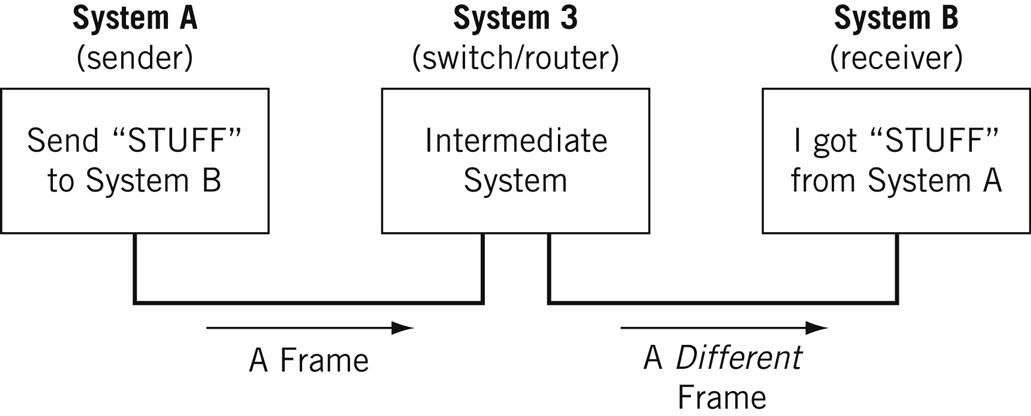
For the nitpicky among us (yep, I see you), host is another term that you will encounter in networking. I will define a host as a type of node that requires an IP address. All hosts are nodes, but not all nodes are hosts. Please Tweet angrily at me if you disagree.
Links connect nodes on a network. Links can be wired, like Ethernet, or cable-free, like WiFi.
Links to can either be point-to-point, where Node A is connected to Node B, or multipoint, where Node A is connected to Node B and Node C.
When we’re talking about information being transmitted, this may also be described as a one-to-one vs. a one-to-many relationship.
A protocol is a mutually agreed upon set of rules that allows two nodes on a network to exchange data.
“A protocol defines the rules governing the syntax (what can be communicated), semantics (how it can be communicated), and synchronization (when and at what speed it can be communicated) of the communications procedure. Protocols can be implemented on hardware, software, or a combination of both. Protocols can be created by anyone, but the most widely adopted protocols are based on standards.” - The Illustrated Network.
Both wired and cable-free links can have protocols.
While anyone can create a protocol, the most widely adopted protocols are often based on standards published by Internet organizations such as the Internet Engineering Task Force (IETF).
A network is a general term for a group of computers, printers, or any other device that wants to share data.
Network types include LAN, HAN, CAN, MAN, WAN, BAN, or VPN. Think I’m just randomly rhyming things with the word can ? I can ’t say I am - these are all real network types. Learn more here .
Topology describes how nodes and links fit together in a network configuration, often depicted in a diagram. Here are some common network topology types:
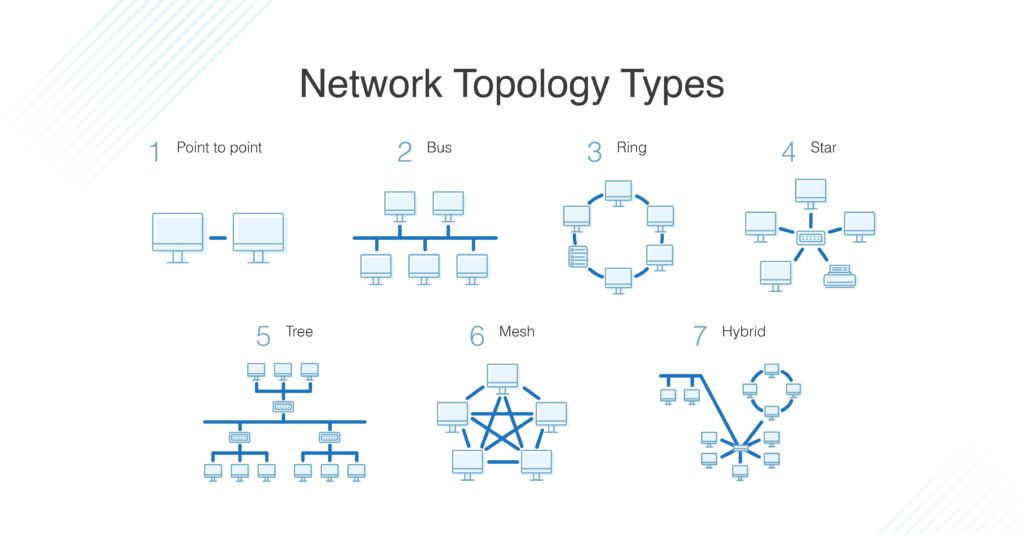
A network consists of nodes, links between nodes, and protocols that govern data transmission between nodes.
At whatever scale and complexity networks get to, you will understand what’s happening in all computer networks by learning the OSI model and 7 layers of networking.
What is the OSI Model?
The OSI model consists of 7 layers of networking.
First, what’s a layer?

No, a layer - not a lair . Here there are no dragons.
A layer is a way of categorizing and grouping functionality and behavior on and of a network.
In the OSI model, layers are organized from the most tangible and most physical, to less tangible and less physical but closer to the end user.
Each layer abstracts lower level functionality away until by the time you get to the highest layer. All the details and inner workings of all the other layers are hidden from the end user.
How to remember all the names of the layers? Easy.
- Please | Physical Layer
- Do | Data Link Layer
- Not | Network Layer
- Tell (the) | Transport Layer
- Secret | Session Layer
- Password (to) | Presentation Layer
- Anyone | Application Layer
Keep in mind that while certain technologies, like protocols, may logically “belong to” one layer more than another, not all technologies fit neatly into a single layer in the OSI model. For example, Ethernet, 802.11 (Wifi) and the Address Resolution Protocol (ARP) procedure operate on >1 layer.
The OSI is a model and a tool, not a set of rules.
OSI Layer 1
Layer 1 is the physical layer . There’s a lot of technology in Layer 1 - everything from physical network devices, cabling, to how the cables hook up to the devices. Plus if we don’t need cables, what the signal type and transmission methods are (for example, wireless broadband).
Instead of listing every type of technology in Layer 1, I’ve created broader categories for these technologies. I encourage readers to learn more about each of these categories:
- Nodes (devices) and networking hardware components. Devices include hubs, repeaters, routers, computers, printers, and so on. Hardware components that live inside of these devices include antennas, amplifiers, Network Interface Cards (NICs), and more.
- Device interface mechanics. How and where does a cable connect to a device (cable connector and device socket)? What is the size and shape of the connector, and how many pins does it have? What dictates when a pin is active or inactive?
- Functional and procedural logic. What is the function of each pin in the connector - send or receive? What procedural logic dictates the sequence of events so a node can start to communicate with another node on Layer 2?
- Cabling protocols and specifications. Ethernet (CAT), USB, Digital Subscriber Line (DSL) , and more. Specifications include maximum cable length, modulation techniques, radio specifications, line coding, and bits synchronization (more on that below).
- Cable types. Options include shielded or unshielded twisted pair, untwisted pair, coaxial and so on. Learn more about cable types here .
- Signal type. Baseband is a single bit stream at a time, like a railway track - one-way only. Broadband consists of multiple bit streams at the same time, like a bi-directional highway.
- Signal transmission method (may be wired or cable-free). Options include electrical (Ethernet), light (optical networks, fiber optics), radio waves (802.11 WiFi, a/b/g/n/ac/ax variants or Bluetooth). If cable-free, then also consider frequency: 2.5 GHz vs. 5 GHz. If it’s cabled, consider voltage. If cabled and Ethernet, also consider networking standards like 100BASE-T and related standards.
The data unit on Layer 1 is the bit.
A bit the smallest unit of transmittable digital information. Bits are binary, so either a 0 or a 1. Bytes, consisting of 8 bits, are used to represent single characters, like a letter, numeral, or symbol.
Bits are sent to and from hardware devices in accordance with the supported data rate (transmission rate, in number of bits per second or millisecond) and are synchronized so the number of bits sent and received per unit of time remains consistent (this is called bit synchronization). The way bits are transmitted depends on the signal transmission method.
Nodes can send, receive, or send and receive bits. If they can only do one, then the node uses a simplex mode. If they can do both, then the node uses a duplex mode. If a node can send and receive at the same time, it’s full-duplex – if not, it’s just half-duplex.
The original Ethernet was half-duplex. Full-duplex Ethernet is an option now, given the right equipment.
How to Troubleshoot OSI Layer 1 Problems
Here are some Layer 1 problems to watch out for:
- Defunct cables, for example damaged wires or broken connectors
- Broken hardware network devices, for example damaged circuits
- Stuff being unplugged (...we’ve all been there)
If there are issues in Layer 1, anything beyond Layer 1 will not function properly.
Layer 1 contains the infrastructure that makes communication on networks possible.
It defines the electrical, mechanical, procedural, and functional specifications for activating, maintaining, and deactivating physical links between network devices. - Source
Fun fact: deep-sea communications cables transmit data around the world. This map will blow your mind: https://www.submarinecablemap.com/
And because you made it this far, here’s a koala:

OSI Layer 2
Layer 2 is the data link layer . Layer 2 defines how data is formatted for transmission, how much data can flow between nodes, for how long, and what to do when errors are detected in this flow.
In more official tech terms:
- Line discipline. Who should talk for how long? How long should nodes be able to transit information for?
- Flow control. How much data should be transmitted?
- Error control - detection and correction . All data transmission methods have potential for errors, from electrical spikes to dirty connectors. Once Layer 2 technologies tell network administrators about an issue on Layer 2 or Layer 1, the system administrator can correct for those errors on subsequent layers. Layer 2 is mostly concerned with error detection, not error correction. ( Source )
There are two distinct sublayers within Layer 2:
- Media Access Control (MAC): the MAC sublayer handles the assignment of a hardware identification number, called a MAC address, that uniquely identifies each device on a network. No two devices should have the same MAC address. The MAC address is assigned at the point of manufacturing. It is automatically recognized by most networks. MAC addresses live on Network Interface Cards (NICs). Switches keep track of all MAC addresses on a network. Learn more about MAC addresses on PC Mag and in this article . Learn more about network switches here .
- Logical Link Control (LLC): the LLC sublayer handles framing addressing and flow control. The speed depends on the link between nodes, for example Ethernet or Wifi.
The data unit on Layer 2 is a frame .
Each frame contains a frame header, body, and a frame trailer:
- Header: typically includes MAC addresses for the source and destination nodes.
- Body: consists of the bits being transmitted.
- Trailer: includes error detection information. When errors are detected, and depending on the implementation or configuration of a network or protocol, frames may be discarded or the error may be reported up to higher layers for further error correction. Examples of error detection mechanisms: Cyclic Redundancy Check (CRC) and Frame Check Sequence (FCS). Learn more about error detection techniques here .
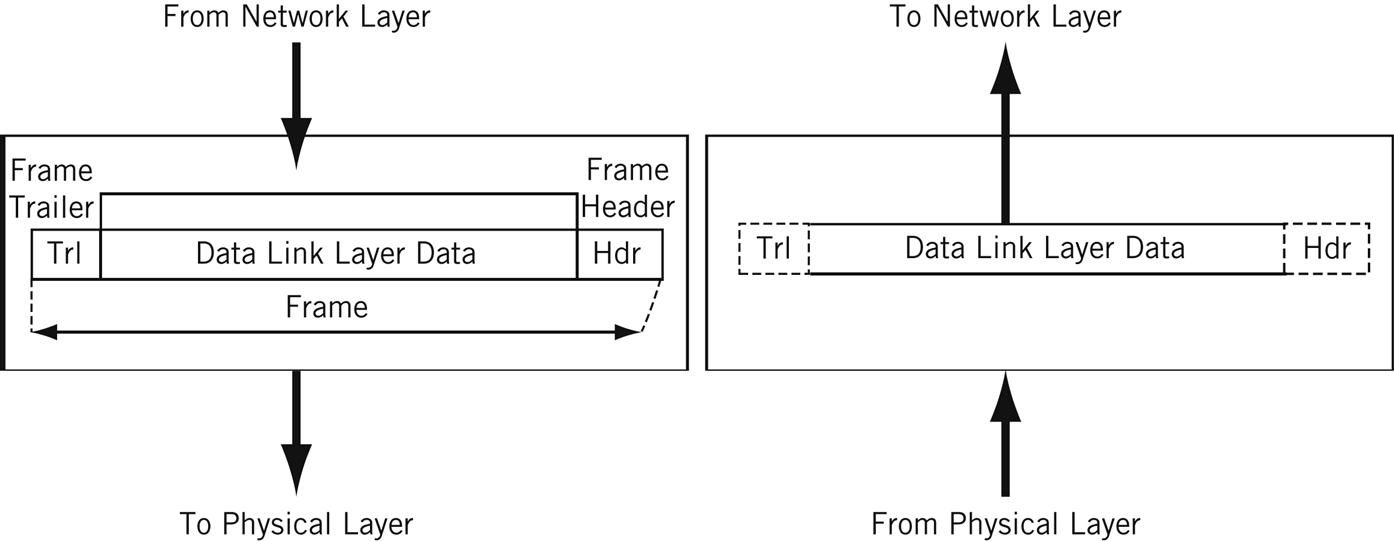
Typically there is a maximum frame size limit, called an Maximum Transmission Unit, MTU. Jumbo frames exceed the standard MTU, learn more about jumbo frames here .
How to Troubleshoot OSI Layer 2 Problems
Here are some Layer 2 problems to watch out for:
- All the problems that can occur on Layer 1
- Unsuccessful connections (sessions) between two nodes
- Sessions that are successfully established but intermittently fail
- Frame collisions
The Data Link Layer allows nodes to communicate with each other within a local area network. The foundations of line discipline, flow control, and error control are established in this layer.
OSI Layer 3
Layer 3 is the network layer . This is where we send information between and across networks through the use of routers. Instead of just node-to-node communication, we can now do network-to-network communication.
Routers are the workhorse of Layer 3 - we couldn’t have Layer 3 without them. They move data packets across multiple networks.
Not only do they connect to Internet Service Providers (ISPs) to provide access to the Internet, they also keep track of what’s on its network (remember that switches keep track of all MAC addresses on a network), what other networks it’s connected to, and the different paths for routing data packets across these networks.
Routers store all of this addressing and routing information in routing tables.
Here’s a simple example of a routing table:

The data unit on Layer 3 is the data packet . Typically, each data packet contains a frame plus an IP address information wrapper. In other words, frames are encapsulated by Layer 3 addressing information.
The data being transmitted in a packet is also sometimes called the payload . While each packet has everything it needs to get to its destination, whether or not it makes it there is another story.
Layer 3 transmissions are connectionless, or best effort - they don't do anything but send the traffic where it’s supposed to go. More on data transport protocols on Layer 4.
Once a node is connected to the Internet, it is assigned an Internet Protocol (IP) address, which looks either like 172.16. 254.1 (IPv4 address convention) or like 2001:0db8:85a3:0000:0000:8a2e:0370:7334 (IPv6 address convention). Routers use IP addresses in their routing tables.
IP addresses are associated with the physical node’s MAC address via the Address Resolution Protocol (ARP), which resolves MAC addresses with the node’s corresponding IP address.
ARP is conventionally considered part of Layer 2, but since IP addresses don’t exist until Layer 3, it’s also part of Layer 3.
How to Troubleshoot OSI Layer 3 Problems
Here are some Layer 3 problems to watch out for:
- All the problems that can crop up on previous layers :)
- Faulty or non-functional router or other node
- IP address is incorrectly configured
Many answers to Layer 3 questions will require the use of command-line tools like ping , trace , show ip route , or show ip protocols . Learn more about troubleshooting on layer 1-3 here .
The Network Layer allows nodes to connect to the Internet and send information across different networks.
OSI Layer 4
Layer 4 is the transport layer . This where we dive into the nitty gritty specifics of the connection between two nodes and how information is transmitted between them. It builds on the functions of Layer 2 - line discipline, flow control, and error control.
This layer is also responsible for data packet segmentation, or how data packets are broken up and sent over the network.
Unlike the previous layer, Layer 4 also has an understanding of the whole message, not just the contents of each individual data packet. With this understanding, Layer 4 is able to manage network congestion by not sending all the packets at once.
The data units of Layer 4 go by a few names. For TCP, the data unit is a packet. For UDP, a packet is referred to as a datagram. I’ll just use the term data packet here for the sake of simplicity.
Transmission Control Protocol (TCP) and User Datagram Protocol (UDP) are two of the most well-known protocols in Layer 4.
TCP, a connection-oriented protocol, prioritizes data quality over speed.
TCP explicitly establishes a connection with the destination node and requires a handshake between the source and destination nodes when data is transmitted. The handshake confirms that data was received. If the destination node does not receive all of the data, TCP will ask for a retry.
TCP also ensures that packets are delivered or reassembled in the correct order. Learn more about TCP here .
UDP, a connectionless protocol, prioritizes speed over data quality. UDP does not require a handshake, which is why it’s called connectionless.
Because UDP doesn’t have to wait for this acknowledgement, it can send data at a faster rate, but not all of the data may be successfully transmitted and we’d never know.
If information is split up into multiple datagrams, unless those datagrams contain a sequence number, UDP does not ensure that packets are reassembled in the correct order. Learn more about UDP here .
TCP and UDP both send data to specific ports on a network device, which has an IP address. The combination of the IP address and the port number is called a socket.
Learn more about sockets here .
Learn more about the differences and similarities between these two protocols here .
How to Troubleshoot OSI Layer 4 Problems
Here are some Layer 4 problems to watch out for:
- Blocked ports - check your Access Control Lists (ACL) & firewalls
- Quality of Service (QoS) settings. QoS is a feature of routers/switches that can prioritize traffic, and they can really muck things up. Learn more about QoS here .
The Transport Layer provides end-to-end transmission of a message by segmenting a message into multiple data packets; the layer supports connection-oriented and connectionless communication.
OSI Layer 5
Layer 5 is the session layer . This layer establishes, maintains, and terminates sessions.
A session is a mutually agreed upon connection that is established between two network applications. Not two nodes! Nope, we’ve moved on from nodes. They were so Layer 4.
Just kidding, we still have nodes, but Layer 5 doesn’t need to retain the concept of a node because that’s been abstracted out (taken care of) by previous layers.
So a session is a connection that is established between two specific end-user applications. There are two important concepts to consider here:
- Client and server model: the application requesting the information is called the client, and the application that has the requested information is called the server.
- Request and response model: while a session is being established and during a session, there is a constant back-and-forth of requests for information and responses containing that information or “hey, I don’t have what you’re requesting.”
Sessions may be open for a very short amount of time or a long amount of time. They may fail sometimes, too.
Depending on the protocol in question, various failure resolution processes may kick in. Depending on the applications/protocols/hardware in use, sessions may support simplex, half-duplex, or full-duplex modes.
Examples of protocols on Layer 5 include Network Basic Input Output System (NetBIOS) and Remote Procedure Call Protocol (RPC), and many others.
From here on out (layer 5 and up), networks are focused on ways of making connections to end-user applications and displaying data to the user.
How to Troubleshoot OSI Layer 5 Problems
Here are some Layer 5 problems to watch out for:
- Servers are unavailable
- Servers are incorrectly configured, for example Apache or PHP configs
- Session failure - disconnect, timeout, and so on.
The Session Layer initiates, maintains, and terminates connections between two end-user applications. It responds to requests from the presentation layer and issues requests to the transport layer.
OSI Layer 6
Layer 6 is the presentation layer . This layer is responsible for data formatting, such as character encoding and conversions, and data encryption.
The operating system that hosts the end-user application is typically involved in Layer 6 processes. This functionality is not always implemented in a network protocol.
Layer 6 makes sure that end-user applications operating on Layer 7 can successfully consume data and, of course, eventually display it.
There are three data formatting methods to be aware of:
- American Standard Code for Information Interchange (ASCII): this 7-bit encoding technique is the most widely used standard for character encoding. One superset is ISO-8859-1, which provides most of the characters necessary for languages spoken in Western Europe.
- Extended Binary-Coded Decimal Interchange Code (EBDCIC): designed by IBM for mainframe usage. This encoding is incompatible with other character encoding methods.
- Unicode: character encodings can be done with 32-, 16-, or 8-bit characters and attempts to accommodate every known, written alphabet.
Learn more about character encoding methods in this article , and also here .
Encryption: SSL or TLS encryption protocols live on Layer 6. These encryption protocols help ensure that transmitted data is less vulnerable to malicious actors by providing authentication and data encryption for nodes operating on a network. TLS is the successor to SSL.
How to Troubleshoot OSI Layer 6 Problems
Here are some Layer 6 problems to watch out for:
- Non-existent or corrupted drivers
- Incorrect OS user access level
The Presentation Layer formats and encrypts data.
OSI Layer 7
Layer 7 is the application layer .
True to its name, this is the layer that is ultimately responsible for supporting services used by end-user applications. Applications include software programs that are installed on the operating system, like Internet browsers (for example, Firefox) or word processing programs (for example, Microsoft Word).
Applications can perform specialized network functions under the hood and require specialized services that fall under the umbrella of Layer 7.
Electronic mail programs, for example, are specifically created to run over a network and utilize networking functionality, such as email protocols, which fall under Layer 7.
Applications will also control end-user interaction, such as security checks (for example, MFA), identification of two participants, initiation of an exchange of information, and so on.
Protocols that operate on this level include File Transfer Protocol (FTP), Secure Shell (SSH), Simple Mail Transfer Protocol (SMTP), Internet Message Access Protocol (IMAP), Domain Name Service (DNS), and Hypertext Transfer Protocol (HTTP).
While each of these protocols serve different functions and operate differently, on a high level they all facilitate the communication of information. ( Source )
How to Troubleshoot OSI Layer 7 Problems
Here are some Layer 7 problems to watch out for:
- All issues on previous layers
- Incorrectly configured software applications
- User error (... we’ve all been there)
The Application Layer owns the services and functions that end-user applications need to work. It does not include the applications themselves.
Our Layer 1 koala is all grown up.

Learning check - can you apply makeup to a koala?
Don’t have a koala?
Well - answer these questions instead. It’s the next best thing, I promise.
- What is the OSI model?
- What are each of the layers?
- How could I use this information to troubleshoot networking issues?
Congratulations - you’ve taken one step farther to understanding the glorious entity we call the Internet.
Learning Resources
Many, very smart people have written entire books about the OSI model or entire books about specific layers. I encourage readers to check out any O’Reilly-published books about the subject or about network engineering in general.
Here are some resources I used when writing this article:
- The Illustrated Network, 2nd Edition
- Protocol Data Unit (PDU): https://www.geeksforgeeks.org/difference-between-segments-packets-and-frames/
- Troubleshooting Along the OSI Model: https://www.pearsonitcertification.com/articles/article.aspx?p=1730891
- The OSI Model Demystified: https://www.youtube.com/watch?v=HEEnLZV2wGI
- OSI Model for Dummies: https://www.dummies.com/programming/networking/layers-in-the-osi-model-of-a-computer-network/
Chloe Tucker is an artist and computer science enthusiast based in Portland, Oregon. As a former educator, she's continuously searching for the intersection of learning and teaching, or technology and art. Reach out to her on Twitter @_chloetucker and check out her website at chloe.dev .
Read more posts .
If you read this far, thank the author to show them you care. Say Thanks
Learn to code for free. freeCodeCamp's open source curriculum has helped more than 40,000 people get jobs as developers. Get started
- Artificial Intelligence
- Generative AI
- Cloud Computing
- CPUs and Processors
- Data Center
- Edge Computing
- Enterprise Storage
- Virtualization
- Internet of Things
- Network Management Software
- Network Security
- Enterprise Buyer’s Guides
- United States
- Newsletters
- Foundry Careers
- Terms of Service
- Privacy Policy
- Cookie Policy
- Copyright Notice
- Member Preferences
- About AdChoices
- E-commerce Links
- Your California Privacy Rights
Our Network
- Computerworld

The OSI model explained and how to easily remember its 7 layers
A tutorial on the open systems interconnection networking reference model and tips on and how to memorize the seven layers.

The Open Systems Interconnect (OSI) model is a conceptual framework that describes networking or telecommunications systems as seven layers, each with its own function.
The layers help network pros visualize what is going on within their networks and can help network managers narrow down problems (is it a physical issue or something with the application?), as well as computer programmers (when developing an application, which other layers does it need to work with?). Tech vendors selling new products will often refer to the OSI model to help customers understand which layer their products work with or whether it works “across the stack”.
The 7 layers of the OSI model
The layers are: Layer 1—Physical; Layer 2—Data Link; Layer 3—Network; Layer 4—Transport; Layer 5—Session; Layer 6—Presentation; Layer 7—Application.
It wasn’t always this way. Conceived in the 1970s when computer networking was taking off, two separate models were merged in 1983 and published in 1984 to create the OSI model that most people are familiar with today. Most descriptions of the OSI model go from top to bottom, with the numbers going from Layer 7 down to Layer 1. The layers, and what they represent, are as follows:
Layer 7 – Application
The Application Layer in the OSI model is the layer that is the “closest to the end user”. It receives information directly from users and displays incoming data to the user. Oddly enough, applications themselves do not reside at the application layer. Instead the layer facilitates communication through lower layers in order to establish connections with applications at the other end. Web browsers (Google Chrome, Firefox, Safari, etc.) TelNet, and FTP, are examples of communications that rely on Layer 7.
Layer 6 – Presentation
The Presentation Layer represents the area that is independent of data representation at the application layer. In general, it represents the preparation or translation of application format to network format, or from network formatting to application format. In other words, the layer “presents” data for the application or the network. A good example of this is encryption and decryption of data for secure transmission; this happens at Layer 6.
Layer 5 – Session
When two computers or other networked devices need to speak with one another, a session needs to be created, and this is done at the Session Layer . Functions at this layer involve setup, coordination (how long should a system wait for a response, for example) and termination between the applications at each end of the session.
Layer 4 – Transport
The Transport Layer deals with the coordination of the data transfer between end systems and hosts. How much data to send, at what rate, where it goes, etc. The best known example of the Transport Layer is the Transmission Control Protocol (TCP), which is built on top of the Internet Protocol (IP), commonly known as TCP/IP. TCP and UDP port numbers work at Layer 4, while IP addresses work at Layer 3, the Network Layer.
Layer 3 – Network
Here at the Network Layer is where you’ll find most of the router functionality that most networking professionals care about and love. In its most basic sense, this layer is responsible for packet forwarding, including routing through different routers . You might know that your Boston computer wants to connect to a server in California, but there are millions of different paths to take. Routers at this layer help do this efficiently.
Layer 2 – Data Link
The Data Link Layer provides node-to-node data transfer (between two directly connected nodes), and also handles error correction from the physical layer. Two sublayers exist here as well–the Media Access Control (MAC) layer and the Logical Link Control (LLC) layer. In the networking world, most switches operate at Layer 2. But it’s not that simple. Some switches also operate at Layer 3 in order to support virtual LANs that may span more than one switch subnet, which requires routing capabilities.
Layer 1 – Physical
At the bottom of our OSI model we have the Physical Layer, which represents the electrical and physical representation of the system. This can include everything from the cable type, radio frequency link (as in a Wi-Fi network), as well as the layout of pins, voltages, and other physical requirements. When a networking problem occurs, many networking pros go right to the physical layer to check that all of the cables are properly connected and that the power plug hasn’t been pulled from the router, switch or computer, for example.
Why you need to know the 7 OSI layers
Most people in IT will likely need to know about the different layers when they’re going for their certifications, much like a civics student needs to learn about the three branches of the US government. After that, you hear about the OSI model when vendors are making pitches about which layers their products work with.
In a Quora post asking about the purpose of the OSI model, Vikram Kumar answered this way:
“The purpose of the OSI reference model is to guide vendors and developers so the digital communication products and software programs they create will interoperate, and to facilitate clear comparisons among communications tools.”
While some people may argue that the OSI model is obsolete (due to its conceptual nature) and less important than the four layers of the TCP/IP model, Kumar says that “it is difficult to read about networking technology today without seeing references to the OSI model and its layers, because the model’s structure helps to frame discussions of protocols and contrast various technologies.”
If you can understand the OSI model and its layers, you can also then understand which protocols and devices can interoperate with each other when new technologies are developed and explained.
The OSI model remains relevant
In a post on GeeksforGeeks, contributor Vabhav Bilotia argues several reasons why the OSI model remains relevant, especially when it comes to security and determining where technical risks and vulnerabilities may exist.
For example, by understanding the different layers, enterprise security teams can identify and classify physical access, where the data is sitting, and provide an inventory of the applications that employees use to access data and resources.
“Knowing where the majority of your company’s data is held, whether on-premises or in cloud services, will help define your information security policy,” writes Bilotia. “You can invest in the correct solutions that provide you data visibility within the proper OSI layers once you have this knowledge.”
In addition, the OSI model can be used to understand cloud infrastructure migrations, particularly when it comes to securing data within the cloud.
And because the model has been around for so long and understood by so many, the uniform vocabulary and terms helps networking professionals understand quickly about the components of the networking system “While this paradigm is not directly implemented in today’s TCP/IP networks, it is a useful conceptual model for relating multiple technologies to one another and implementing the appropriate technology in the appropriate way,” Bilotia writes. We couldn’t agree more.
How to remember the OSI Model 7 layers – 8 mnemonic tricks
If you need to memorize the layers for a college or certification test, here are a few sentences to help remember them in order. The first letter of each word is the same as the first letter an OSI layer.
From Application to Physical (Layer 7 to Layer 1):
- All People Seem To Need Data Processing
- All Pros Search Top Notch Donut Places
- A Penguin Said That Nobody Drinks Pepsi
- A Priest Saw Two Nuns Doing Pushups
From Physical to Application (Layer 1 to Layer 7):
- Please Do Not Throw Sausage Pizza Away
- Pew! Dead Ninja Turtles Smell Particularly Awful
- People Don’t Need To See Paula Abdul
- Pete Doesn’t Need To Sell Pickles Anymore
Keith Shaw was a Network World editor and the writer of the Cool Tools column. He is now a freelance writer and editor from Worcester, Mass.
Related content
What is a virtual machine, and why are they so useful, what is dns and how does it work, appeal court overturns $1.6bn mainframe software ‘poaching’ ruling against ibm, cisco, red hat extend networking, ai integrations, newsletter promo module test.

The first gadget Keith Shaw ever wanted was the Merlin, a red plastic toy that beeped and played Tic-Tac-Toe and various other games. A child of the '70s and teenager of the '80s, Shaw has been a fan of computers, technology and video games right from the start. He won an award in 8th grade for programming a game on the school's only computer, and saved his allowance to buy an Atari 2600.
Shaw has a bachelor's degree in newspaper journalism from Syracuse University and has worked at a variety of newspapers in New York, Florida and Massachusetts, as well as Computerworld and Network World. He won an award from the American Society of Business Publication Editors for a 2003 article on anti-spam testing, and a Gold Award in their 2010 Digital Awards Competition for the "ABCs of IT" video series.
Shaw is also the co-creator of taquitos.net , the crunchiest site on the InterWeb, which has taste-tested and reviewed more than 4,000 varieties of snack foods.
More from this author
What is a network switch and how does it work, what is zero trust network access, what is sd-wan, and what does it mean for networking, security, cloud, most popular authors.

- Elizabeth Montalbano
Show me more
Nscale offers amd ai chips-as-a-service in green data center.

Palo Alto extends SASE security, performance features

The logic of && and || on Linux

Has the hype around ‘Internet of Things’ paid off? | Ep. 145

Episode 1: Understanding Cisco’s Converged SDN Transport

Episode 2: Pluggable Optics and the Internet for the Future

Has the hype around ‘Internet of Things’ paid off?

Are unused IPv4 addresses a secret gold mine?

Preparing for a 6G wireless world: Exciting changes coming to the wireless industry

- Editor's Choice: Tech Gifts for Mom
- iPad Pro vs. Surface Pro: What's the Difference?
The Layers of the OSI Model Illustrated
Each layer explained
- Massachusetts Institute of Technology
- University of Illinois
:max_bytes(150000):strip_icc():format(webp)/image-5e6611aebe974bb7886a24b5070c834f.jpg)
- The Wireless Connection
- Routers & Firewalls
- Network Hubs
- Installing & Upgrading
- Wi-Fi & Wireless
The Open Systems Interconnection (OSI) model defines a networking framework to implement protocols in layers, with control passed from one layer to the next. It is primarily used today as a teaching tool. It conceptually divides computer network architecture into 7 layers in a logical progression.
The lower layers deal with electrical signals, chunks of binary data , and routing of these data across networks. Higher levels cover network requests and responses, representation of data, and network protocols, as seen from a user's point of view.
The OSI model was originally conceived as a standard architecture for building network systems, and many popular network technologies today reflect the layered design of OSI.
Physical Layer
At Layer 1, the Physical layer of the OSI model is responsible for the ultimate transmission of digital data bits from the Physical layer of the sending (source) device over network communications media to the Physical layer of the receiving (destination) device.
Examples of layer 1 technologies include Ethernet cables and hubs . Also, hubs and other repeaters are standard network devices that function at the Physical layer, as are cable connectors.
At the Physical layer, data is transmitted using the type of signaling supported by the physical medium: electric voltages, radio frequencies, or pulses of infrared or ordinary light.
Data Link Layer
When obtaining data from the Physical layer, the Data Link layer checks for physical transmission errors and packages bits into data frames. The Data Link layer also manages physical addressing schemes such as MAC addresses for Ethernet networks, controlling access of network devices to the physical medium.
Because the Data Link layer is the most complex layer in the OSI model, it is often divided into two parts: the Media Access Control sub-layer and the Logical Link Control sub-layer.
Network Layer
The Network layer adds the concept of routing above the Data Link layer. When data arrives at the Network layer, the source and destination addresses contained inside each frame are examined to determine if the data has reached its final destination. If the data has reached the final destination, layer 3 formats the data into packets delivered to the Transport layer. Otherwise, the Network layer updates the destination address and pushes the frame down to the lower layers.
To support routing, the Network layer maintains logical addresses such as IP addresses for devices on the network. The Network layer also manages the mapping between these logical addresses and physical addresses. In IPv4 networking, this mapping is accomplished through the Address Resolution Protocol (ARP); IPv6 uses Neighbor Discovery Protocol (NDP).
Transport Layer
The Transport Layer delivers data across network connections. TCP (Transmission Control Protocol) and UDP (User Datagram Protocol) are the most common examples of Transport Layer 4 network protocols. Different transport protocols may support a range of optional capabilities, including error recovery, flow control, and support for re-transmission.
Session Layer
The Session Layer manages the sequence and flow of events that initiate and tear down network connections. At layer 5, it is built to support multiple types of connections that can be created dynamically and run over individual networks.
Presentation Layer
The Presentation layer has the simplest function of any piece of the OSI model. At layer 6, it handles syntax processing of message data such as format conversions and encryption/decryption needed to support the Application layer above it.
Application Layer
The Application layer supplies network services to end-user applications. Network services are protocols that work with the user's data. For example, in a web browser application, the Application layer protocol HTTP packages the data needed to send and receive web page content. This layer 7 provides data to (and obtains data from) the Presentation layer.
Get the Latest Tech News Delivered Every Day
- Common Questions and Answers on the OSI Network Model
- A Guide to X.25 in Computer Networking
- OSI Model Reference Guide
- Wireless Access Point vs. Wireless Application Protocol
- Visual Index of Computer Networking Topics
- Here's Why Your Network Might Need a Layer 3 Switch
- Understanding Transmission Control Protocol/Internet Protocol (TCP/IP)
- What Is PPTP: Point-to-Point Tunneling Protocol
- How Do Computer Network Protocols Work?
- Beginner's Guide to Asynchronous Transfer Mode (ATM)
- ARP (Address Resolution Protocol) and Your Computer Network
- What Is a Virtual LAN (VLAN)?
- Use a Bridge to Expand Your Local Network
- A Short Guide on Networking Fundamentals
- What Are Network Protocols?
- What Is a Switch?
Understanding the Application Layer in the OSI Model
Last Edited
The Application Layer, positioned as the topmost layer in the Open Systems Interconnection (OSI) model, is pivotal in network architecture. It serves as the window for users and applications to access network services.
This article delves into the nuances of the Application Layer, exploring its functions, protocols, and significance in enabling network communication and application services. It’s an essential read for anyone looking to deepen their understanding of network protocols and how they facilitate effective communication in digital networks. Let’s begin!
Table of Contents:
- Overview of the Application Layer
- Protocols in the Application Layer
- Real-World Applications of the Application Layer
- Interaction with Other OSI Layers
- Challenges and Solutions in the Application Layer
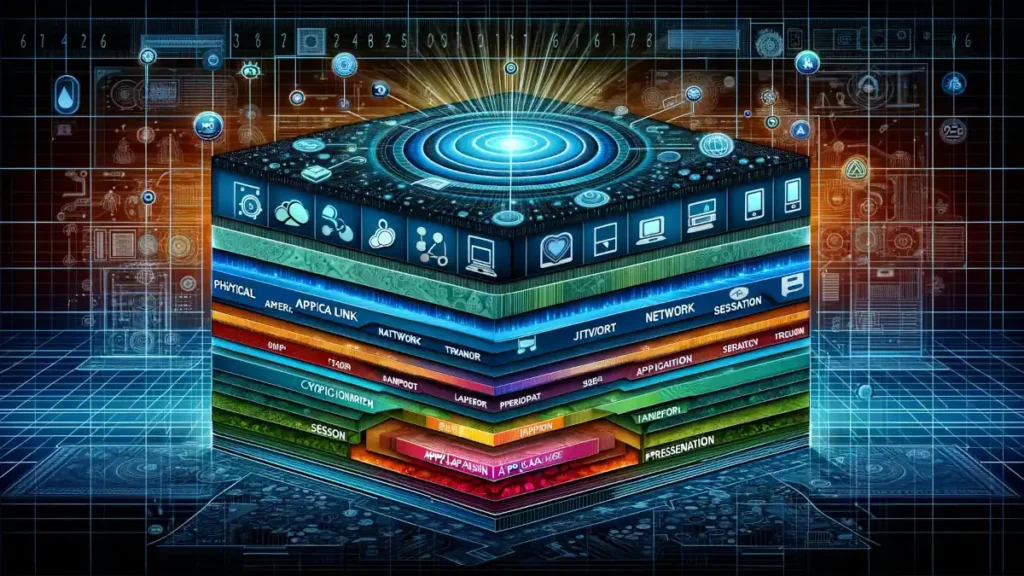
1. Overview of the Application Layer
Role and function, interface to network services:.
The Application Layer in the OSI model is the conduit through which end-users and applications communicate with network services. This layer is the user’s gateway to the network, where application-level communications like email sending, file transfers, and website access occur. It encapsulates user-level processes and facilitates the interpretation of requests and responses between the network and the user.
- Responsibility for Service Requests and Responses: The Application Layer is accountable for initiating service requests to other network devices and handling incoming responses. It translates user actions and commands into network operations, ensuring that the requests are understandable and executable by the lower layers of the OSI model.
Data Exchange Formats:
One of the critical functions of the Application Layer is to define the standards and structures for data exchange formats.
- Protocol Definitions for Syntax and Encryption: This layer specifies protocol rules, including syntax, semantics, and synchronization of communication. Protocols like HTTP for web browsing and SMTP for email rely on the Application Layer for these specifications.
- Session Management: It is responsible for managing sessions, ensuring that data transfers are complete and accurate. This management includes maintaining data integrity and security during communication.
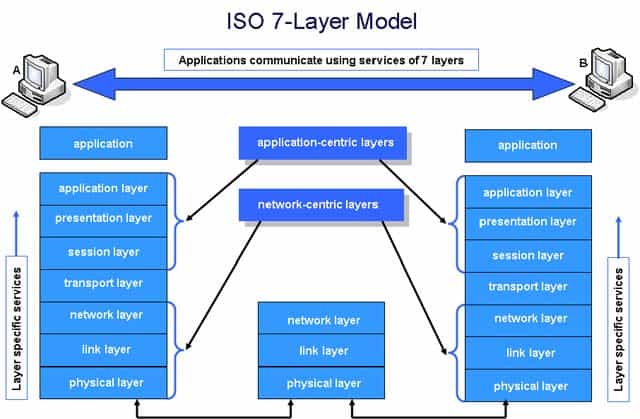
Key Responsibilities
Resource sharing:.
The Application Layer plays a vital role in enabling the sharing of resources over a network.
- Efficient Utilization of Network Resources: It allows multiple users to access and utilize shared network resources such as printers and files, optimizing resource use and improving collaboration efficiency.
Remote File Access:
This layer facilitates access to files located on remote servers, making it a cornerstone for distributed computing and cloud storage services.
- Access and Management of Files Over a Network: Users can retrieve, modify, and store files on a server located remotely, enhancing accessibility and data mobility.
Mail Services:
One of the most commonly used services of the Application Layer is in the domain of email communication.
- Management of Email Transmission and Storage: Protocols like SMTP ( Simple Mail Transfer Protocol ) and POP3 ( Post Office Protocol 3 ) operate at this layer to manage the sending, receiving, and storing of emails. This functionality includes directing emails to the correct recipients and storing them appropriately for later retrieval.
2. Protocols in the Application Layer
The Application Layer of the OSI model hosts a variety of protocols, each designed to fulfill specific communication and data transfer needs across the network. These protocols define how data is formatted, transmitted, and received, and they often incorporate security measures to safeguard data integrity and confidentiality.
Common Protocols
Http (hypertext transfer protocol):.
HTTP stands as the foundational protocol for data communication on the World Wide Web. It facilitates the transfer of hypertext and multimedia content over the internet.
- Function: HTTP defines how messages are formatted and transmitted, and how web servers and browsers should respond to various commands.
- Use Case: When a user visits a website, their browser sends an HTTP request to the server hosting the site, which then responds with the requested pages.
SMTP (Simple Mail Transfer Protocol):
SMTP is the standard protocol for sending emails across the internet.
- Function: It governs the sending of emails from a client to a mail server and from server to server.
- Use Case: When an email is sent, SMTP routes it from the sender’s email server to the recipient’s email server.
FTP (File Transfer Protocol):
FTP is used for the transfer of files between a client and a server on a network.
- Function: It provides a way for users to upload, download, and manage files on a remote server.
- Use Case: FTP is often used for transferring large files, managing website files, or for backup systems.
DNS (Domain Name System):
DNS translates human-readable domain names (like www.example.com ) into machine-readable IP addresses.
- Function: It ensures users can access websites using familiar domain names instead of having to remember numerical IP addresses.
- Use Case: When a user types a URL into their browser, DNS servers translate it into an IP address that points to the web server hosting that site.
Protocol Characteristics
Communication standards:.
Each protocol in the Application Layer has a set of specific rules and standards governing communication.
- Data Formatting and Encapsulation: Protocols define the structure of the messages exchanged, including headers, footers, and payload organization.
- Data Delivery Mechanisms: They specify how data should be transmitted, ensuring compatibility and interoperability between different systems and devices.
Security Measures:
Many Application Layer protocols include built-in security features to protect data integrity and confidentiality.
- Encryption: Protocols like HTTPS (an extension of HTTP) incorporate encryption to secure data transmission, especially important for sensitive transactions.
- Authentication: Protocols often have mechanisms for verifying the identity of users and devices, ensuring that only authorized entities can access data or services. For example, email protocols have authentication methods to verify users before allowing access to email accounts.
3. Real-World Applications of the Application Layer
The Application Layer in the OSI model is integral to numerous everyday and advanced technological functionalities. This chapter explores the real-world applications of the Application Layer, demonstrating its ubiquity and critical role in modern computing and communication.
Everyday Use Cases
Web browsing:.
One of the most common uses of the Application Layer is in web browsing, where HTTP and HTTPS protocols are fundamental.
- HTTP and HTTPS: These protocols are used for accessing and transmitting web content. While HTTP facilitates the basic exchange of information over the web, HTTPS adds a layer of security through encryption, ensuring safe data transfer, especially for sensitive transactions like online banking or shopping.
- Use Case Example: Accessing any website through a browser involves sending an HTTP request, which is handled by the Application Layer.

Email Communication:
Email communication relies heavily on protocols operating at the Application Layer, such as SMTP, POP3, and IMAP.
- SMTP: Used primarily for sending emails.
- POP3 and IMAP: Used for retrieving emails from a server. While POP3 downloads emails to the local device, IMAP allows users to view emails directly from the server, facilitating access from multiple devices.
- Use Case Example: Sending an email through an email client uses SMTP, while checking for new emails utilizes POP3 or IMAP.
File Transfers:
Protocols like FTP and SFTP provide mechanisms for file uploads and downloads, essential in numerous contexts.
- FTP and SFTP: FTP is used for transferring files between computers on a network, while SFTP adds a layer of security by encrypting data transfers.
- Use Case Example: Uploading files to a web server for website maintenance or downloading large data files from a remote server.
Advanced Implementations
Apis and web services:.
Application Layer protocols are pivotal in the functioning of APIs and web services, which are fundamental to modern web applications and services.
- Role in APIs: These protocols enable different software applications to communicate and exchange data, whether they are on the same network or across the internet.
- Web Services: RESTful web services commonly use HTTP/HTTPS for operations, allowing for interoperable machine-to-machine interaction.
- Use Case Example: A mobile app retrieving weather data from a remote server using a web service.
Cloud Computing:
In cloud computing , Application Layer protocols are instrumental in delivering various services, including Software as a Service (SaaS), Platform as a Service (PaaS), and Infrastructure as a Service (IaaS).
- SaaS: Protocols enable users to access software applications over the internet.
- PaaS and IaaS: They facilitate the delivery of computing platforms and infrastructure as services over the internet, allowing developers and users to access and utilize cloud-based resources.
- Use Case Example: Accessing a cloud-based CRM system (SaaS) or deploying applications on cloud platforms (PaaS).
4. Interaction with Other OSI Layers
In the OSI model, the Application Layer does not operate in isolation; it interacts synergistically with the Presentation and Session layers to facilitate complete and efficient communication processes.
Session and Presentation Layers
Data preparation:.
The Application Layer closely works with the Presentation Layer , which is responsible for data format translation. This translation includes converting data from a format used by the application layer into a common format at the sending station and then back into the application’s format at the receiving station.
- Role of the Presentation Layer: It handles the syntax and semantics of the information transmitted, ensuring that data from the application layer of one system is understandable by the application layer of another system.
- Example: Converting different file formats (JPEG, PDF, etc.) into a standard format for transmission and then back into their original formats upon receipt.
Session Management:
The Application Layer also collaborates with the Session Layer to manage and control the dialogue between computers. It establishes, manages, and terminates the connections between the local and remote application.
- Control of Dialogues: The Session Layer sets up, coordinates, and terminates conversations, exchanges, and dialogues between the applications at each end. It deals with session and connection coordination.
- Example: Managing a continuous file transfer operation, ensuring data synchronization and orderly communication.
5. Challenges and Solutions in the Application Layer
Security concerns, vulnerability to attacks:.
The Application Layer is frequently targeted in cyber attacks, such as data breaches and DDoS attacks. These attacks can exploit vulnerabilities in application layer protocols to gain unauthorized access or disrupt services.
- Mitigation Strategies: Implementing firewalls and intrusion detection/prevention systems to monitor and filter malicious traffic. Regularly updating and patching applications to fix security vulnerabilities.
- Example: Deploying web application firewalls to protect web applications from various attacks.
Encryption and Authentication:
To protect data integrity and confidentiality, robust encryption and authentication mechanisms are critical in the Application Layer.
- Implementing Encryption: Using protocols like HTTPS, which incorporates SSL/TLS encryption, to secure data transmissions.
- Strong Authentication Protocols: Implementing authentication methods like OAuth and two-factor authentication to verify user identities and prevent unauthorized access.
- Example: Secure online transactions using HTTPS, ensuring data like credit card details are encrypted and secure.
Performance Optimization
Load balancing:.
Load balancing is essential for managing high network traffic, ensuring that no single server bears too much demand.
- Techniques: Distributing workload evenly across multiple servers to maximize throughput, minimize response time, and avoid overloading any single server.
- Example: Using DNS round-robin technique to distribute incoming requests evenly across multiple servers.
Protocol Efficiency:
Optimizing protocols at the Application Layer can greatly improve performance and reduce latency.
- Streamlining Protocols: Ensuring protocols are as efficient as possible, reducing overhead, and improving speed.
- Data Compression: Implementing data compression techniques to reduce the amount of data being transmitted, thereby increasing speed and efficiency.
- Example: Minimizing HTTP requests in web applications to improve page load times.
In summary, the Application Layer’s interaction with other layers in the OSI model enhances its functionality, particularly in data preparation and session management. However, it faces challenges in terms of security and performance, which can be addressed through robust security protocols, efficient load balancing, and protocol optimization. These measures are crucial for maintaining the integrity, security, and efficiency of Application Layer operations.
6. Conclusion
The Application Layer in the OSI Model is a cornerstone in network communication, playing a crucial role in facilitating user interactions and data exchange over networks.
Its protocols and services form the basis of many of our daily digital interactions, from web browsing to file sharing. Understanding the intricacies of this layer is fundamental for network professionals, developers, and anyone interested in the mechanics of network communication.
7. References
- “ Computer Networking: A Top-Down Approach ” by James Kurose and Keith Ross
- “ Data Communications and Networking ” by Behrouz A. Forouzan
- IETF Protocol Specifications
- OSI Model Overview by the International Organization for Standardization

OSI Presentation and Application Layers
Cite this chapter.

- Paul D. Bartoli 3
Part of the book series: Applications of Communications Theory ((ACTH))
251 Accesses
This chapter discusses the Application and Presentation Layers of the Reference Model of Open Systems Interconnection (OSI) [1]. The Application and Presentation Layers perform functions necessary to exchange information between application processes; the Application Layer is concerned with the semantic aspects of the information exchange, while the Presentation Layer is concerned with the syntactic aspects. The ability to manage the semantic and syntactic elements of the information to be exchanged is key to ensuring that the information can be interpreted by the communicants.
This is a preview of subscription content, log in via an institution to check access.
Access this chapter
- Available as PDF
- Read on any device
- Instant download
- Own it forever
- Compact, lightweight edition
- Dispatched in 3 to 5 business days
- Free shipping worldwide - see info
Tax calculation will be finalised at checkout
Purchases are for personal use only
Institutional subscriptions
Unable to display preview. Download preview PDF.
ISO 7498, “Information processing systems—Open Systems Interconnection—Basic Reference Model,” 1984. CCITT Recommendation X.200, “Reference model of open systems interconnection for CCITT applications,” 1984 (updated expected in 1988).
Google Scholar
ISO DIS 9545, “Information processing systems—Open Systems Interconnection—Application Layer structure,” September 1988.
ISO TR 9007, “Concepts and terminology for the conceptual schema and the information base,” 1985.
ISO 8649, “Information processing systems—Open systems interconnection—Service definition for the association control service element,” 1988. ISO 8650, “Information processing systems—Open systems interconnection—Protocol specification for the association control service element,” 1988. CCITT Recommendation X.217, “Association control service definition for open systems interconnection for CCITT applications,” 1988. CCITT Recommendation X.227, “Association control protocol specification for open systems interconnection for CCITT applications,” final text December, 1987.
ISO 8571, “Information processing systems—Open systems interconnection—File transfer, access, and management,” Parts 1–4, 1988.
ISO/DIS 9804, “Information processing systems”Open systems interconnection—Service definition for commitment, concurrency, and recovery,” 1988 (text in SC 21 N 2573, March, 1988). ISO DIS 9805, “Information processing systems—Open systems interconnection—Protocol specification for commitment, concurrency, and recovery,” 1988 (text in SC 21 N 2574, March, 1988). CCITT Recommendation X.237, “Commitment, concurrency, and recovery service definition,” Draft Text, 1988. CCITT Recommendation X.247, “Commitment, concurrency, and recovery protocol specification, Draft Text, 1988.
ISO DIS 9040, “Information processing systems—Open systems interconnection—Virtual terminal service—Basic class,” 1988 (text in SC 21 N 2615, March, 1988). ISO DIS 9041, “Information processing systems—Open systems interconnection—Virtual terminal protocol—Basic class,” 1988 (text in SC 21 N 2616, March, 1988).
ISO DIS 9066–1, “Reliable transfer service”, 1988 (text in SC 18 N 1408, March, 1988). ISO DIS 9066–2, “Reliable transfer protocol specification,” 1988 (text in SC 18 N 1409). CCITT Recommendation X.218, “Reliable transfer: Model and service definition,” 1988. CCITT Recommendation X.228, “Reliable transfer: Protocol specification,” 1988.
ISO DIS 9072–1, “Remote operations service,” 1988 (text in SC 18 N 1410, March, 1988). ISO DIS 9072–2, “Remote operations protocol specification,” 1988 (text in SC 18 N 1411, March, 1988). CCITT Recommendation X.219, “Remote operations: Model, notation, and service definition,” 1988. CCITT Recommendation X.229, “Remote operations: Protocol specification,” 1988.
ISO DIS 9594, “Information processing—Open systems interconnection—The directory,” parts 1–8, 1988 (text in SC 21 N 2751 through N 2758, April, 1988). CCITT X.500, “Series recommendations on directory,” November, 1987.
ISO DIS 10021, “Information processing—Text communication—Message oriented text interchange system,” 1988 (text in SC 18 N 1487 through N 1493, May, 1988). CCITT X.400, “Series recommendations for message handling systems,” 1988.
ISO 8613/1–8, “Office document architecture and interchange format,” 1988, awaiting publication. CCITT T.400, “Series recommendations for document architecture, transfer, and manipulation,” 1988.
ISO 8824, “Information processing systems—Open systems interconnection—Specification of abstract syntax notation one (ASN.1),” 1987; and ISO 8824/PDAD 1, “Information processing systems—Open systems interconnection—Specification for ASN.1: Proposed draft Addendum 1 on ASN.1 extensions,” 1988 (final text in SC 21 N 2341 Revised, April, 1988). CCITT Recommendation X.208, “Specification of abstract syntax notation one (ASN.1),” 1988.
ISO 8822, “Information processing systems—Open systems interconnection—Connection oriented presentation service definition,” 1988. CCITT Recommendation X.216, “Presentation service definition for open systems interconnection for CCITT applications,” 1988.
ISO 8825, “Information processing—Open systems interconnection—Specification of basic encoding rules for abstract syntax notation one (ASN.1),” 1987; and ISO 8825/ PDAD 1, “Information processing systems—Open systems interconnection—Specification of basic encoding rules for ASN.1: Proposed draft addendum 1 on ASN.1 extensions,” 1988 (text in SC 21 N 2342 Revised, April, 1988). CCITT Recommendation X.209, “Specification of basic encoding rules for abstract syntax notation one (ASN.1),” 1988.
ISO 8823, “Information processing systems—Open systems interconnection—Connection oriented presentation protocol specification,” 1988. CCITT Recommendation X.226, “Presentation protocol specification for open systems interconnection for CCITT applications,” 1988.
ISO 8326, “Information processing systems—Open systems interconnection—Basic connection oriented session service definition,” 1987; and ISO 8326/AD 2, “Information processing systems—Open systems interconnection—Basic connection oriented session service definition—Addendum 2: Incorporation of unlimited user data,” 1988. ISO 8327, “Information processing systems—Open systems interconnection—Basic connection oriented session protocol specification,” 1987; and ISO 8327/AD 2, “Information processing systems—Open systems interconnection—Basic connection oriented session protocol specification—Addendum 2: Unlimited session user data protocol specification,” 1988.
CCITT Recommendation X.215, “Session service definition for open systems interconnection for CCITT applications,” 1988. CCITT Recommendation X.225, “Session protocol specification for open systems interconnection for CCITT applications,” 1988.
Download references
Author information
Authors and affiliations.
AT&T Bell Laboratories, 07733, Holmdel, New Jersey, USA
Paul D. Bartoli
You can also search for this author in PubMed Google Scholar
Editor information
Editors and affiliations.
Unisys West Coast Research Center, Santa Monica, 90406, California, USA
Carl A. Sunshine
Rights and permissions
Reprints and permissions
Copyright information
© 1989 Plenum Press, New York
About this chapter
Bartoli, P.D. (1989). OSI Presentation and Application Layers. In: Sunshine, C.A. (eds) Computer Network Architectures and Protocols. Applications of Communications Theory. Springer, Boston, MA. https://doi.org/10.1007/978-1-4613-0809-6_13
Download citation
DOI : https://doi.org/10.1007/978-1-4613-0809-6_13
Publisher Name : Springer, Boston, MA
Print ISBN : 978-1-4612-8093-4
Online ISBN : 978-1-4613-0809-6
eBook Packages : Springer Book Archive
Share this chapter
Anyone you share the following link with will be able to read this content:
Sorry, a shareable link is not currently available for this article.
Provided by the Springer Nature SharedIt content-sharing initiative
- Publish with us
Policies and ethics
- Find a journal
- Track your research

Three-tier architecture is a well-established software application architecture that organizes applications into three logical and physical computing tiers: the presentation tier, or user interface; the application tier, where data is processed; and the data tier, where application data is stored and managed.
The chief benefit of three-tier architecture is that because each tier runs on its own infrastructure, each tier can be developed simultaneously by a separate development team. And can be updated or scaled as needed without impacting the other tiers.
For decades three-tier architecture was the prevailing architecture for client-server applications. Today, most three-tier applications are targets for modernization that uses cloud-native technologies such as containers and microservices and for migration to the cloud.
Connect and integrate your systems to prepare your infrastructure for AI.
Register for the guide on app modernization
Presentation tier
The presentation tier is the user interface and communication layer of the application, where the end user interacts with the application. Its main purpose is to display information to and collect information from the user. This top-level tier can run on a web browser, as desktop application, or a graphical user interface (GUI), for example. Web presentation tiers are developed by using HTML, CSS, and JavaScript. Desktop applications can be written in various languages depending on the platform.
Application tier
The application tier, also known as the logic tier or middle tier, is the heart of the application. In this tier, information that is collected in the presentation tier is processed - sometimes against other information in the data tier - using business logic, a specific set of business rules. The application tier can also add, delete, or modify data in the data tier.
The application tier is typically developed by using Python, Java, Perl, PHP or Ruby, and communicates with the data tier by using API calls.
The data tier, sometimes called database tier, data access tier or back-end, is where the information that is processed by the application is stored and managed. This can be a relational database management system such as PostgreSQL , MySQL, MariaDB, Oracle, Db2, Informix or Microsoft SQL Server, or in a NoSQL Database server such as Cassandra, CouchDB , or MongoDB .
In a three-tier application, all communication goes through the application tier. The presentation tier and the data tier cannot communicate directly with one another.
Tier versus layer
In discussions of three-tier architecture, layer is often used interchangeably – and mistakenly – for tier , as in 'presentation layer' or 'business logic layer'.
They aren't the same. A 'layer' refers to a functional division of the software, but a 'tier' refers to a functional division of the software that runs on infrastructure separate from the other divisions. The Contacts app on your phone, for example, is a three - layer application, but a single-tier application, because all three layers run on your phone.
The difference is important because layers can't offer the same benefits as tiers.
Again, the chief benefit of three-tier architecture is its logical and physical separation of functionality. Each tier can run on a separate operating system and server platform - for example, web server, application server, database server - that best fits its functional requirements. And each tier runs on at least one dedicated server hardware or virtual server, so the services of each tier can be customized and optimized without impacting the other tiers.
Other benefits (compared to single- or two-tier architecture) include:
- Faster development : Because each tier can be developed simultaneously by different teams, an organization can bring the application to market faster. And programmers can use the latest and best languages and tools for each tier.
- Improved scalability : Any tier can be scaled independently of the others as needed.
- Improved reliability : An outage in one tier is less likely to impact the availability or performance of the other tiers.
- Improved security : Because the presentation tier and data tier can't communicate directly, a well-designed application tier can function as an internal firewall, preventing SQL injections and other malicious exploits.
In web development, the tiers have different names but perform similar functions:
- The web server is the presentation tier and provides the user interface. This is usually a web page or website, such as an ecommerce site where the user adds products to the shopping cart, adds payment details or creates an account. The content can be static or dynamic, and is developed using HTML, CSS, and JavaScript.
- The application server corresponds to the middle tier, housing the business logic that is used to process user inputs. To continue the ecommerce example, this is the tier that queries the inventory database to return product availability, or adds details to a customer's profile. This layer often developed using Python, Ruby, or PHP and runs a framework such as Django, Rails, Symphony, or ASP.NET.
- The database server is the data or backend tier of a web application. It runs on database management software, such as MySQL, Oracle, DB2, or PostgreSQL.
While three-tier architecture is easily the most widely adopted multitier application architecture, there are others that you might encounter in your work or your research.
Two-tier architecture
Two-tier architecture is the original client-server architecture, consisting of a presentation tier and a data tier; the business logic lives in the presentation tier, the data tier or both. In two-tier architecture the presentation tier - and therefore the end user - has direct access to the data tier, and the business logic is often limited. A simple contact management application, where users can enter and retrieve contact data, is an example of a two-tier application.
N-tier architecture
N-tier architecture - also called or multitier architecture - refers to any application architecture with more than one tier. But applications with more than three layers are rare because extra layers offer few benefits and can make the application slower, harder to manage and more expensive to run. As a result, n-tier architecture and multitier architecture are usually synonyms for three-tier architecture.
Move to cloud faster with IBM Cloud Pak solutions running on Red Hat OpenShift software—integrated, open, containerized solutions certified by IBM®.
Seamlessly modernize your VMware workloads and applications with IBM Cloud.
Modernize, build new apps, reduce costs, and maximize ROI.
IBM Consulting® application modernization services, which are powered by IBM Consulting Cloud Accelerator, offers skills, methods, tools, and initiatives that help determine the right strategy based on your portfolio. To modernize and containerize legacy system applications and accelerate the time-to-value of hybrid cloud environments.
Discover what application modernization is, the common benefits and challenges, and how to get started.
Learn about how relational databases work and how they compare to other data storage options.
Explore cloud native applications and how they drive innovation and speed within your enterprise.
Modernize your legacy three-tier applications on your journey to cloud. Whether you need assistance with strategy, processes, or capabilities—or want full-service attention—IBM can help. Start using containerized middleware that can run in any cloud—all bundled in IBM Cloud Paks.
Home > Learning Center > OSI Model
Article's content

Need help protecting your applications?
See how imperva can help, what is the osi model.
The Open Systems Interconnection (OSI) model describes seven layers that computer systems use to communicate over a network. It was the first standard model for network communications, adopted by all major computer and telecommunication companies in the early 1980s
The modern Internet is not based on OSI, but on the simpler TCP/IP model. However, the OSI 7-layer model is still widely used, as it helps visualize and communicate how networks operate, and helps isolate and troubleshoot networking problems.
OSI was introduced in 1983 by representatives of the major computer and telecom companies, and was adopted by ISO as an international standard in 1984.
OSI Model Explained: The OSI 7 Layers
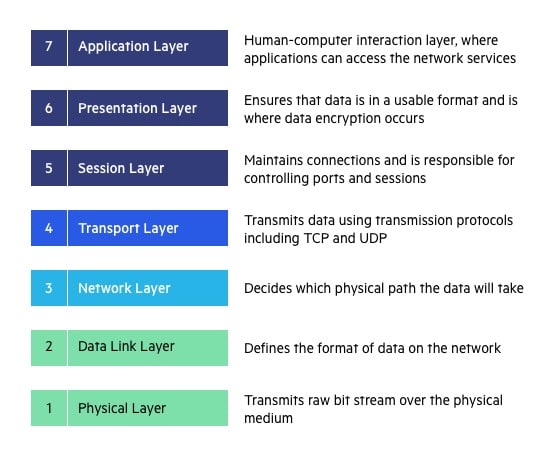
We’ll describe OSI layers “top down” from the application layer that directly serves the end user, down to the physical layer.
7. Application Layer
The application layer is used by end-user software such as web browsers and email clients. It provides protocols that allow software to send and receive information and present meaningful data to users. A few examples of application layer protocols are the Hypertext Transfer Protocol (HTTP), File Transfer Protocol (FTP), Post Office Protocol (POP), Simple Mail Transfer Protocol (SMTP), and Domain Name System (DNS).
6. Presentation Layer
The presentation layer prepares data for the application layer. It defines how two devices should encode, encrypt, and compress data so it is received correctly on the other end. The presentation layer takes any data transmitted by the application layer and prepares it for transmission over the session layer.
5. Session Layer
The session layer creates communication channels, called sessions, between devices. It is responsible for opening sessions, ensuring they remain open and functional while data is being transferred, and closing them when communication ends. The session layer can also set checkpoints during a data transfer—if the session is interrupted, devices can resume data transfer from the last checkpoint.
4. Transport Layer
The transport layer takes data transferred in the session layer and breaks it into “segments” on the transmitting end. It is responsible for reassembling the segments on the receiving end, turning it back into data that can be used by the session layer. The transport layer carries out flow control, sending data at a rate that matches the connection speed of the receiving device, and error control, checking if data was received incorrectly and if not, requesting it again.
3. Network Layer
The network layer has two main functions. One is breaking up segments into network packets, and reassembling the packets on the receiving end. The other is routing packets by discovering the best path across a physical network. The network layer uses network addresses (typically Internet Protocol addresses) to route packets to a destination node.
2. Data Link Layer
The data link layer establishes and terminates a connection between two physically-connected nodes on a network. It breaks up packets into frames and sends them from source to destination. This layer is composed of two parts—Logical Link Control (LLC), which identifies network protocols, performs error checking and synchronizes frames, and Media Access Control (MAC) which uses MAC addresses to connect devices and define permissions to transmit and receive data.
1. Physical Layer
The physical layer is responsible for the physical cable or wireless connection between network nodes. It defines the connector, the electrical cable or wireless technology connecting the devices, and is responsible for transmission of the raw data, which is simply a series of 0s and 1s, while taking care of bit rate control.
Advantages of OSI Model
The OSI model helps users and operators of computer networks:
- Determine the required hardware and software to build their network.
- Understand and communicate the process followed by components communicating across a network.
- Perform troubleshooting, by identifying which network layer is causing an issue and focusing efforts on that layer.
The OSI model helps network device manufacturers and networking software vendors:
- Create devices and software that can communicate with products from any other vendor, allowing open interoperability
- Define which parts of the network their products should work with.
- Communicate to users at which network layers their product operates – for example, only at the application layer, or across the stack.

Build a Robust API Security Strategy in 2024
Register Now
OSI vs. TCP/IP Model
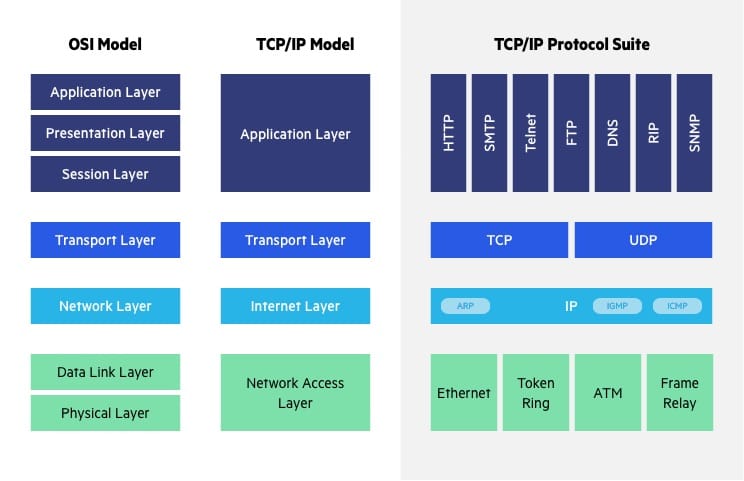
The Transfer Control Protocol/Internet Protocol (TCP/IP) is older than the OSI model and was created by the US Department of Defense (DoD). A key difference between the models is that TCP/IP is simpler, collapsing several OSI layers into one:
- OSI layers 5, 6, 7 are combined into one Application Layer in TCP/IP
- OSI layers 1, 2 are combined into one Network Access Layer in TCP/IP – however TCP/IP does not take responsibility for sequencing and acknowledgement functions, leaving these to the underlying transport layer.
Other important differences:
- TCP/IP is a functional model designed to solve specific communication problems, and which is based on specific, standard protocols. OSI is a generic, protocol-independent model intended to describe all forms of network communication.
- In TCP/IP, most applications use all the layers, while in OSI simple applications do not use all seven layers. Only layers 1, 2 and 3 are mandatory to enable any data communication.
See how Imperva Web Application Firewall can help you with application security.
Imperva Application Security
Imperva security solutions secure your applications across multiple layers of the OSI model, from the network layer, protected by Imperva DDoS mitigation, to Imperva’s web application firewall (WAF), bot management and API security technology that safeguards the application layer.
To secure applications and networks across the OSI stack, Imperva provides multi-layered protection to make sure websites and applications are available, easily accessible and safe. The Imperva applicati on security solution includes:
- DDoS Protection —maintain uptime in all situations. Prevent any type of DDoS attack, of any size, from preventing access to your website and network infrastructure.
- CDN —enhance website performance and reduce bandwidth costs with a CDN designed for developers. Cache static resources at the edge while accelerating APIs and dynamic websites.
- WAF —cloud-based solution permits legitimate traffic and prevents bad traffic, safeguarding applications at the edge. Gateway WAF keeps applications and APIs inside your network safe.
- Bot protection —analyzes your bot traffic to pinpoint anomalies, identifies bad bot behavior and validates it via challenge mechanisms that do not impact user traffic.
- API security —protects APIs by ensuring only desired traffic can access your API endpoint, as well as detecting and blocking exploits of vulnerabilities.
- Account takeover protection —uses an intent-based detection process to identify and defends against attempts to take over users’ accounts for malicious purposes.
- RASP —keep your applications safe from within against known and zero‑day attacks. Fast and accurate protection with no signature or learning mode.
- Attack analytics —mitigate and respond to real cyber security threats efficiently and accurately with actionable intelligence across all your layers of defense.
Latest Blogs

Nadav Avital
Apr 4, 2024 2 min read

Mar 28, 2024 4 min read

Daniel Johnston
, Yohann Sillam
Mar 20, 2024 3 min read

Feb 19, 2024 6 min read

, Sofia Naer
Dec 19, 2023 2 min read

Dec 14, 2023 5 min read

Dec 14, 2023 3 min read

- Imperva Threat Research

Erez Hasson
, Gabi Stapel
Nov 8, 2023 13 min read
Latest Articles
- Cybersecurity 101
182.3k Views
118.1k Views
110.8k Views
96.6k Views
77.9k Views
57.1k Views
56.1k Views
2024 Bad Bot Report
Bad bots now represent almost one-third of all internet traffic
The State of API Security in 2024
Learn about the current API threat landscape and the key security insights for 2024
Protect Against Business Logic Abuse
Identify key capabilities to prevent attacks targeting your business logic
The State of Security Within eCommerce in 2022
Learn how automated threats and API attacks on retailers are increasing
Prevoty is now part of the Imperva Runtime Protection
Protection against zero-day attacks
No tuning, highly-accurate out-of-the-box
Effective against OWASP top 10 vulnerabilities
An Imperva security specialist will contact you shortly.
Top 3 US Retailer

CCNA 200-301
- CCNA 200-301 Labs
- CCNP 350-401 ENCOR
- CCNP 350-401 ENCOR Labs
- CCNP 300-410 ENARSI
- CCIE Enterprise Infrastructure
- Cisco Packet Tracer Lab Course
- NRS II IRP Course
- NRS II MPLS Course
- NRS II Service Architecture
- Nokia Configuration Course
- Nokia SRC Program
- JNCIA Junos
- HCIA (HCNA)
- HCIA Configuration Course
- What is Huawei R&S Certification?
- Huawei ICT Certifications
- Python Course
- IPv6 Course
- IP Multicast Course
- NRS I Configuration Course
- Cisco Packet Tracer How To Guide
- Online Courses
- Udemy Courses
- CCNA Flashcard Questions
- Protocol Cheat Sheets
- Subnetting Cheat Sheet
- Linux Cheat Sheet
- Python Cheat Sheet
- CLI Commands Cheat Sheets
- Miscellaneous Cheat Sheets
- Cisco Packet Tracer Labs
- Cisco GNS3 Labs
- Huawei eNSP Labs
- Nokia GNS3 Labs
- Short Config Videos
- Network Tools
- IPCisco on Social Media
- Network Engineer Interview Questions
- Personality Interview Training
- Sign In/Up | Members
- Lost password
- Sign In/Sign Up
- ENROLL HERE

- OSI Referance Model

Table of Contents
OSI Model and TCP/IP Model
Computer network communication are a little complex. To understand this communication, experts divides computer network communication into different layers. To do this division, there are two standard models. These models are OSI Model and TCP/IP Model . Both of these models has different layers. OSI Model has 7 layers and TCP/IP model has 4 or 5 layers. Here, we will focus on OSI Reference Model.
As a beginner in networking, OSI Model and TCP/IP Model are very important to understand the network world. These two common standards has also been a classical question of a network engineer technical interviews . These questions are like: What are the layers of OSI Model ? How many Layers does TCP/IP Model has? What is the role of Data Link Layer?, Which devices works on Network Layer? Which protocols are there in Transport layer? etc…
Now, let’s start with the details of OSI Model Layers . In another lesson, we will talk about TCP/IP Model and its layers detailly.
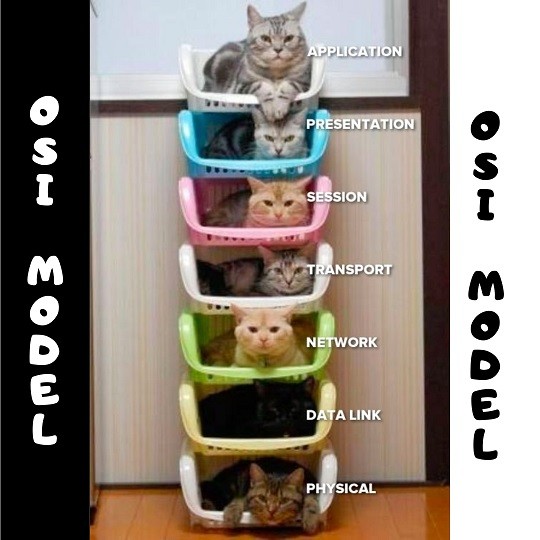
OSI Reference Model is the first term that a network engineer learn in networking. It is generally the first lesson of almost all the certification courses. It is also generally always encountered especially at the technical job interviews of junior network engineers. But OSI Model is only a visionary concept. In real network operations, you will not think about this standard and its layers.
So, what is this Referance Model? What are these OSI Layers ? Below, you can find these layers orderly from starting at the bottom, from Layer 1, to Layer 7, to the top.
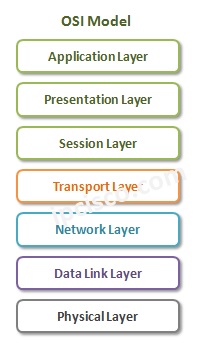
Physical Layer (Layer 1)
- Data-link Layer (Layer 2)
Network Layer (Layer 3)
Transport layer (layer 4), session layer (layer 5), presentation layer (layer 6), application layer (layer 7).
As you can see, there are 7 layers in OSI Reference Model. The first four layers are the Lower Layers and the last three layers are Upper Layers . If we compare OSI and TCP/IP Models, Lowers layers of these models has some differences, but the application layer of TCP/IP model is similar to the upper layers od OSI model.
So, whats are the roles of each OSI Model Layer ? Lets talk about them one by one detailly
Physical Layer (Layer 1) is the actual connectivity between the source and the destination. It is the layer in which the physical characteristic of the network is defined and bit flow transfer is done. These bits are determined with signals . These signals can be both analog and digital. Electrical signals are used for fixed connections and radio signals are used for wireless connections.
In other words, bit flow is done in this level, in other words meaningful 0 and 1 bits are transferred here. Basically, it is the layer in which bit streams are transferred over different media types. Network cabling , different types of cables and network connectors are on physical layer of OSI Model .
As a simple and old network equipment, simple hubs works in physical layer (layer 1). Because, there are not smart devices and on layer 1, there is no need for a smart device.
Below, you can find operation examples in Layer 1. The upper two are a little complex but the lower two can be a good examples:)
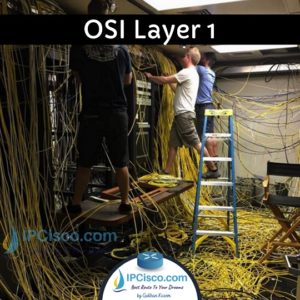
Data-link Layer (Layer 2)
Data-link Layer (Layer 2) is the medium provision Layer. It defines how data is formatted for the transmission over physical medium. Layer 2 provides, node-to node connectivity. It is also the layer of physical MAC addresses .
The most important devices work on layer 2 of OSI Model is Layer 2 switches . As a network engineer, a network technician or a network admin, you will work on these data-link layer devices too much.
Data Link Layer encapsulates the data by adding a layer 2 header and layer 2 trailer . The data after adding Layer 2 Header and layer 2 trailer is called “ frame ”. Layer 2 header contains source and destination MAC Addresses . So, it is responsible to find the next destination in the network. For decapsulation, it also removes these header and trailer and sends the data to the upper network layer.
Data Link Layer provides Error-free transfer of different categories of data frames. It detects physical layer errors and corrects them.
Different network protocols and standards are used in the different layers of OSI model. You can think them as the groups of rules. According to these protocols and standards, network technologies are used and device configurations are done.
Ethernet is one of the most popular protocol in data link layer. Ethernet is the general name of the standard which is used in our home or office networks. It defines a lot of things like cable types, data speed etc.
There are other protocols and standards in data link layers. Some of them are: PPP, HDLC, FDDI, ATM, Frame Relay.
Data-link Layer has two sub-layers . These layers are:
- Media Access Control (MAC) Layer
- Logical Link Control (LLC) Layer
The MAC Sub Layer controls how a computer on the network gains access to the data and permission to transmit it. And it carries the physical address of each device on the network.
The Logical Link Control (LLC) responsible for managing frames to upper and lower layers, Flow control mechanism and Error checking.
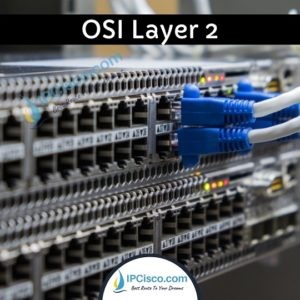
Network Layer is the layer of logical addressing. This layer decides the logical address of the destination with IP addresses. By doing this, it connects different networks that use different medias each other. These addresses can be IPv4 address or IPv6 address .
Network layer is also responsible for routing . With routing, it decides the path of the packets through the network. In other words, it defines the routers that the data will go through. This is one of the popular areas for network engineers :) So, routing protocols works on layer 3 (network layer).
A Layer 3 Header (IP Header for IP) is added to the data in this layer. After this addition, frame is called as “ packet ”. In this header also the next level protocol is mentioned. It can be any transport layer protocol like, TCP , UDP and SCTP .
Frame fragmentation is also done in this Layer. If a frame is longer than MTU (Maximum Transmission Unit) , then it is fragmented (divided to the little packets).
There are different protocols used in network layer of OSI. Some of these protocols are IPv4, IPv6, ICMP, IPSec, OSPF, BGP etc.
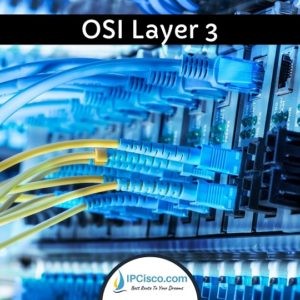
Transport Layer (Layer 4) establishes, maintains and manages end to end secure connection. This layer allows multiple transports on same physical connection.
Transport layer is responsible for end-to-end Error Recovery and Flow Control . Transport Layer is also the Layer that QoS facilities also performed.
Different transport layer protocols are used in this layer. According to used Layer 4 protocol, Layer 4 Header is added to the packet in this Layer. After this the packet called “ segment ”.
There are two common Transport Layer Protocols. These Protocols are UDP (User Datagram Protocol) and TCP (Transmission Control Protocol) . There are also other Transport Layer Protocols like SCTP, RSVP etc. But in CCNA, we will focus on TCP and UDP. We will explain the details of these protocols in the following lessons.
Below, you can find some of TCP layer 4 operations and transport layer protocols comparison.
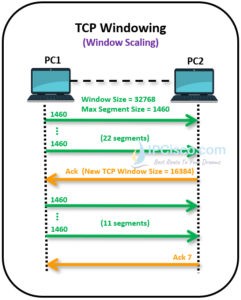
Session Layer (Layer 5) is the OSI layer, that responsible for session jobs between the end points. It provides session establishment, maintenance and termination. Logging is also done in this layer. One of the other main roles of this session layer is multiplexing transport layer services.
Session layer is mainly used by applications themselves. So, network engineers do not work on this layer. This is the job of application developers.
Log in to a computer for file transfer can be an example of session layer job.
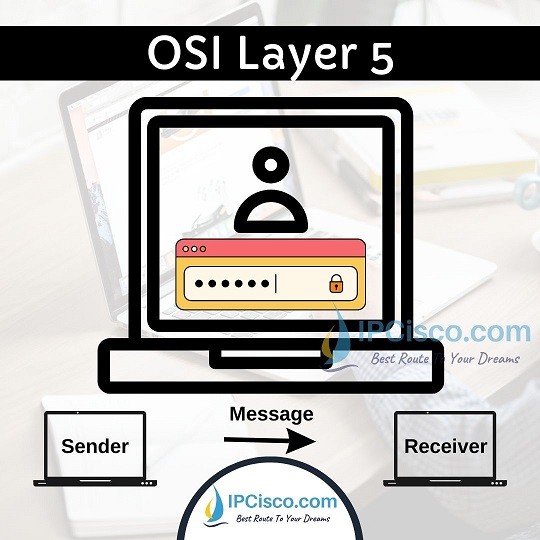
Presentation Layer (Layer 6) is the Translator of the network. There are many data formats in any network. This layer provides translation between different formats.
For example, image formats like jpeg, gif, voice formats like mp3 and video format like mp4 are all need different behaviors. Presentation layer converts this different data into a readable format.
Encryption and compression of the data are also done in presentation layer (layer 6) of OSI Model.
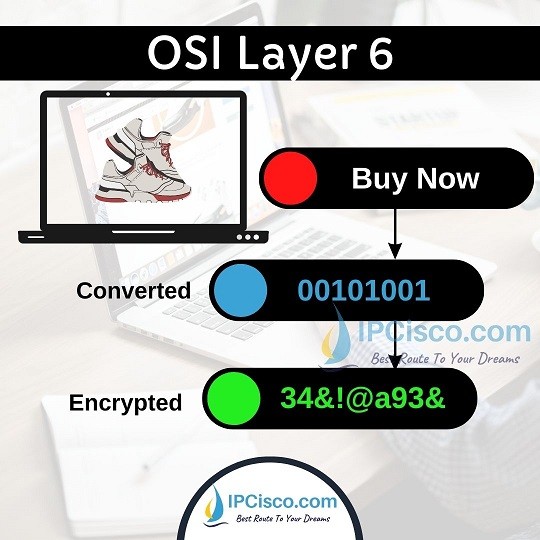
Application Layer (Layer 7) is the closest layer to user. It is the interface between applications and the underlying Layers. It provides the provision of the communication between Applications. Application Layer let programs to reach different network resources.
Some of the protocols used in Application Layer are Telnet, FTP , SMTP, HTTPS, SSL etc. Different services work with these protocols. For example, the browser that you use internet, works with HTTP. By the way, the application itself is not belong to this layer.
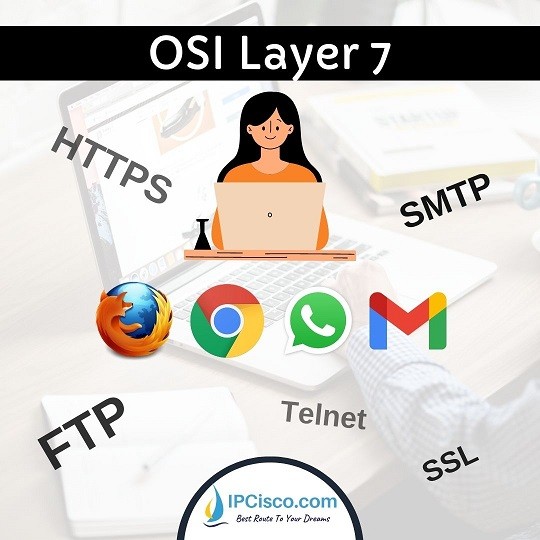
- Network Devices
As you know in a network there are some common network devices like Hubs, Repeaters, Bridges, Switches and Routers. These devices operates in different Layers of OSI model. Lets check this devices and the Layers they are used.
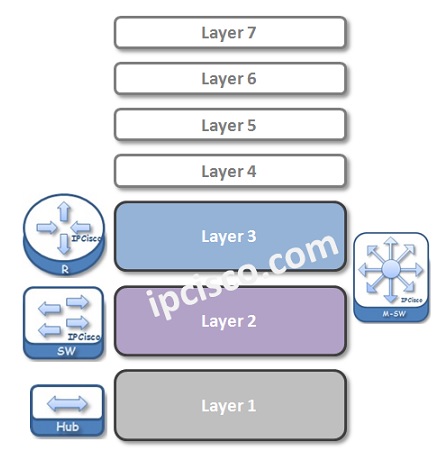
Everything begins with the data at the Application Layer. Then through out the destination, in each Lower Layer, an additional Header is added to these Data. And at the Physical Layer, all these are send via 1s and 0s as voltages over the cables.
What are these Headers of OSI Model Layers and how effects the data?
- At Transport Layer , Layer 4 Header is added. Here the name of “Data and Layer 4 Header” is “ Segment ”.
- At Network Layer , Layer 3 Header is added. Here the name of “Data and Layer 3 Header” is “ Packet ”.
- At Data-Link Layer , Layer 2 Header is added. Here the name of “Data and Layer 2 Header” is “ Frame ”.
- At Physical Layer , all of them is translate to 1s and 0s as voltages.And these values are sent and received over different media types(cables).

Leave a Reply Cancel reply
Your email address will not be published. Required fields are marked *
Network Fundamentals
- Collision Domain vs Broadcast Domain
- Coaxial Cable Details
- Types of Networks
- Top Internet Access Technologies
- WAN Topology Types
- Network Topology Architectures
- Power Over Ethernet (PoE)
- Ethernet Collisions and Troubleshooting
- Cisco NGFW and Cisco NGIPS
- Networking Connectors
- Ping Command
- Basic Cisco Router Configuration on Packet Tracer
- ICMP (Internet Control Message Protocol)
- Address Resolution Protocol (ARP)
- Network Cabling
- TCP/IP Model
IPv4 Addressing
- Verify IP Parameters for Client OS
- IPv4 vs IPv6 Comparison
- Cisco IP Address Configuration
- APIPA Address
- Private IP Address Ranges
- Subnetting Examples
- IP Addressing (IPv4)
- IP Subnetting and Subnetting Examples
TCP and UDP
- TCP Header : Sequence & Acknowledgement Number
- TCP Handshake
- TCP versus UDP
- UDP (User Datagram Protocol)
- TCP (Transmission Control Protocol)
- TCP Header : TCP Options
- TCP Header : TCP Window Size, Checksum & Urgent Pointer
- TCP Header : TCP Flags
- Voice VLAN Configuration
- Packet Tracer VLAN Example 2
- How to Configure Cisco VLANs
- VTP Configuration with Packet Tracer
- VTP (VLAN Trunking Protocol)
- DTP and VLAN Frame Tagging protocols ISL, dot1.q
- Cisco Packet Tracer VLAN Configuration Example
- VLAN Port Assignment and VLAN Port Types
- VLANs (Virtual Local Area Networks)
Switching and LANs
- Ethernet Basics
- Cisco Switch Configuration on Cisco Packet Tracer
- MAC Address Lookup
- What is a mac address
- Local Area Networks
- Network Topologies
- Hubs, Switches and Routers
Spanning Tree Protocol
- Loop Guard, Uplink Fast, Backbone Fast and UDLD
- Portfast, Root Guard, BPDU Filter and BPDU Guard
- PVST+ and Rapid PVST+
- STP (Spanning Tree Protocol) Example on Packet Tracer
- RSTP Configuration on Packet Tracer
- STP Portfast Configuration with Packet Tracer
- Spanning Tree Protocol Operation
- Rapid Spanning Tree Protocol (RSTP)
- Spanning Tree Protocol (STP)
Neighbor Discovery
- LLDP Configuration on Cisco IOS
- Neighbour Discovery Protocols
- CDP Configuration with Packet Tracer
EtherChannels
- PAgP Configuration on Cisco Devices
- LACP Configuration on Cisco Devices
- Link Aggregation Control Protocol (LACP)
Routing Fundamentals
- Route Summarization
- Routing Path Determination
- Routing Table
- Static Routes
- IPv4 Floating Static Routes
- Inter VLAN Routing Configuration on Packet Tracer
- Switch Virtual Interface Configuration on Packet Tracer
- Switch Virtual Interfaces
- Inter VLAN Routing with Router on Stick
- IP and Layer 3 Overview
- Static Route Configuration on Cisco Routers
- Dynamic Routing Protocols
- OSPF Cost and SPF Algorithm
- OSPFv3 Configuration Example on Cisco IOS
- OSPFv3 (Open Shortest Path First Version 3)
- Cisco Single Area OSPF Configuration
- Other OSPF Key Points
- OSPF Network Types
- OSPF Area Types
- OSPF LSA Types
- OSPF Packet Types
- OSPF Adjacency
- OSPF(Open Shortest Path First) Overview
WAN (Wide Area Networks)
- MLPPP Configuration on Cisco Packet Tracer
- What is MLPPP?
- Metro Ethernet Technology
- WAN and WAN Technologies
DHCP and DNS
- DNS Configuration on Cisco Routers
- Domain Name System Overview
- Router DHCP Configuration with Packet Tracer
- DHCP IP Allocation Operation
- DHCP (Dynamic Host Configuration Protocol)
- NAT (Network Address Translation)
- PAT Configuration with Packet Tracer
- Dynamic NAT Configuration with Packet Tracer
- Static NAT Configuration with Packet Tracer
First Hop Redundancy
- HSRP Configuration on Cisco IOS
- HSRP (Hot Standby Router Protocol)
- First Hop Redundancy Protocols (FHRPs)
Network Management
- Syslog Overview
- Configuration Register
- TFTP, FTP, SFTP and SCP
- SSH Configuration on Packet Tracer
- Syslog Configuration Cisco
- Cisco NTP Configuration
- NTP (Network Time Protocol)
- SNMP Overview
- SNMP Configuration On Cisco IOS
- Cisco Router Password Recovery
- IPv6 Floating Static Routes
- IPv6 Static and Default Route Configuration
- Stateless Address Auto Configuration
- IPv6 NDP (Neighbour Discovery Protocol)
- IPv6 Configuration on Cisco Packet Tracer
- What does IPv6 bring?
- Subnetting in IPv6
- IPv6 Address Types
- IPv4 and IPv6 Headers
- IPv6 and IPv6 Addresses
Quality of Service
- Network Traffic Types
- Policing and Shaping in QoS
- Classification and Marking in QoS
- Quality of Service Overview
- Radius Configuration for Wireless Users
- Cisco RADIUS Server Configuration on Packet Tracer
- TACACS+ Overview
- RADIUS Overview
- AAA Protocols : RADIUS and TACACS+
- Authentication, Authorization, Accounting (AAA)
- WLAN Frequency Bands
- Other Wireless Network Extention Types
- Wireless Principles
- WLAN Components
- Wireless Network Design Models
- WLC Management Access Connections
- Wireless Access Point Modes
- Wireless Security Protocols
- WLAN Configuration on Packet Tracer
Security Fundamentals
- DHCP Snooping Configuration on Packet Tracer
- Cisco Banner Configuration on Packet Tracer
- What is DHCP Snooping?
- Access Control Lists
- Multifactor Authentication (MFA)
- Dynamic ARP Inspection
- Cyber Attacks, Network Attacks, Threats and Mitigation
- 802.1x (Port Based Network Access Control)
- Switch Port Security Configuration on Cisco Packet Tracer
- Switch Port Security
- Extended Access List Configuration With Packet Tracer
- Standard Access List Configuration With Packet Tracer
- Basic Cisco Router Security Configuration
Automation and Programmability
- Ansible vs Puppet vs Chef
- Chef Overview
- Puppet Overview
- Ansible Overview
- Network Automation Tools
- Interpret JSON Encoded Data
- Cisco DNA Center
- Cisco SD-Access
- Data Serialization Languages: JSON, YAML, XML
- Traditional Network Management versus Cisco DNA Center
- Cisco DNA and Intent-Based Networking (IBN)
- How Network Automation Impacts Network Management
SDN (Software Defined Networking)
- What is SDN ?
- Traditional Network Drawbacks Versus SDN
- What Will SDN Bring?
- SDN Architecture Components
- SDN Terminology
- Virtualization
- Virtual Network Structure
Latest Lessons
- Coaxial Cable Details Part of: CCNA 200-301
- IPv4 vs IPv6 Comparison Part of: CCNA 200-301
- IGMPv3 Overview Part of: IP Multicast Course
- IGMPv3 Overview Part of: CCIE Enterprise Infrastructure
- Subnetting IPv6 Part of: CCIE Enterprise Infrastructure
- IPv6 and Subnetting Part of: CCNP Enterprise 350-401 ENCOR
- IPv6 Link Local Address Type Part of: CCIE Enterprise Infrastructure
- Cisco Switch Configuration on Cisco Packet Tracer Part of: CCNA 200-301
- Switch Configuration on Cisco Packet Tracer Part of: Cisco Packet Tracer Lab Course
- REST API Security Part of: CCNP Enterprise 350-401 ENCOR
- More Lessons
Latest Blog Posts
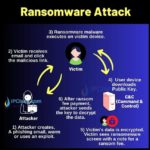
WHAT YOU WILL FIND?
- 250.000+ Students All Over The World
- 8.000+ Questions & Answers
- 100+ Lab Files & Cheat Sheets
- 30+ IT/Network Courses
- A Real Desire To Help You
- Daily Social Media Shares
- %100 Satisfaction
- CISCO Courses
- NOKIA Courses
- HUAWEI Courses
- JUNIPER Courses
- PYTHON Course
- KEY Courses
- VIDEO Courses
- UDEMY Courses
- Cheat Sheets
- Configuration Files
- Interview Questions
- IPCisco On Social Media
- Pärnu mnt. 139c – 14, 11317, Tallinn, Estonia
- [email protected]
Presentation layer and Session layer of the OSI model
There are two popular networking models: the OSI layers model and the TCP/IP layers model. The presentation layer and session layer exist only in the OSI layers models. The TCP/IP layers model merges them into the application layer.
The Presentation Layer
The presentation layer is the sixth layer of the OSI Reference model. It defines how data and information is transmitted and presented to the user. It translates data and format code in such a way that it is correctly used by the application layer.
It identifies the syntaxes that different applications use and formats data using those syntaxes. For example, a web browser receives a web page from a web server in the HTML language. HTML language includes many tags and markup that have no meaning for the end user but they have special meaning for the web browser. the web browser uses the presentation layer's logic to read those syntaxes and format data in such a way the web server wants it to be present to the user.

On the sender device, it encapsulates and compresses data before sending it to the network to increase the speed and security of the network. On the receiver device, it de-encapsulates and decompresses data before presenting it to the user.
Examples of the presentation layer
Example standards for representing graphical information: JPEG, GIF, JPEG, and TIFF.
Example standards for representing audio information: WAV, MIDI, MP3.
Example standards for representing video information: WMV, MOV, MP4, MPEG.
Example standards for representing text information: doc, xls, txt, pdf.
Functions of the presentation layer
- It formats and presents data and information.
- It encrypts and compresses data before giving it to the session layer.
- It de-encrypts and decompresses the encrypted and compressed data it receives from the session layer.
Session layer
The session layer is the fifth layer of the OSI layers model. It is responsible for initiating, establishing, managing, and terminating sessions between the local application and the remote applications.
It defines standards for three modes of communication: full duplex, half-duplex, and simplex.

In the full duplex mode, both devices can send and receive data simultaneously. The internet connection is an example of the full duplex mode.
In the half duplex mode, only one device can send data at a time. A telephone conversation is an example of the half-duplex mode.
In the simplex mode, only one device can send data. A radio broadcast is an example of the simplex mode.
Functions of the session layer
- It is responsible for terminating sessions, creating checkpoints, and recovering data when sessions are interrupted.
- It opens and maintains logical communication channels between network applications running on the local host and network applications running on the remote host.
- If a network application uses an authentication mechanism before it opens a logical communication channel (session) with the remote host, it handles the authentication process.
Examples of the session layer
Structure Query Language (SQL), Remote Procedure Call (RPC), and Network File System (NFS) are examples of the session layer.
By ComputerNetworkingNotes Updated on 2023-10-30 05:30:01 IST
ComputerNetworkingNotes CCNA Study Guide Presentation layer and Session layer of the OSI model
We do not accept any kind of Guest Post. Except Guest post submission, for any other query (such as adverting opportunity, product advertisement, feedback, suggestion, error reporting and technical issue) or simply just say to hello mail us [email protected]

Layer 7 Application Layer
Top Level APIs; Application Networking
Services, applications and network management. The application layer provides functions for applications. This layer provides the connection to the lower layers. At this level, the data input and output takes place. The applications themselves are not in the layer. Typical Applications: web browser, email client, ...
OSI Layer 7 - Application Layer
An application layer is an abstraction layer that specifies the shared protocols and interface methods used by hosts in a communications network. The application layer abstraction is used in both of the standard models of computer networking; the Internet Protocol Suite (TCP/IP) and the Open Systems Interconnection model (OSI model). Although both models use the same term for their respective highest level layer, the detailed definitions and purposes are different. In TCP/IP, the application layer contains the communications protocols and interface methods used in process-to-process communications across an Internet Protocol (IP) computer network. The application layer only standardizes communication and depends upon the underlying transport layer protocols to establish host-to-host data transfer channels and manage the data exchange in a client-server or peer-to-peer networking model. Though the TCP/IP application layer does not describe specific rules or data formats that applications must consider when communicating, the original specification (in RFC 1123) does rely on and recommend the robustness principle for application design. In the OSI model, the definition of the application layer is narrower in scope. The OSI model defines the application layer as the user interface responsible for displaying received information to the user. In contrast, the Internet Protocol model does not concern itself with such detail. OSI also explicitly distinguishes additional functionality below the application layer, but above the transport layer at two additional levels; the session layer and the presentation layer. OSI specifies a strict modular separation of functionality at these layers and provides protocol implementations for each layer. Wikipedia
Popular Application Layer Protocols
Layer 7 application layer, layer 6 presentation layer, layer 5 session layer, layer 4 transport layer, layer 3 network layer, layer 2 data link layer, layer 1 physical layer.

Computer Network
- Operating Systems
- Computer Fundamentals
- Interview Q
Physical Layer
Data link layer, network layer, routing algorithm, transport layer, application layer, application protocols, network security.
Interview Questions
- Send your Feedback to [email protected]
Help Others, Please Share

Learn Latest Tutorials
Transact-SQL
Reinforcement Learning
R Programming
React Native
Python Design Patterns
Python Pillow
Python Turtle
Preparation

Verbal Ability

Company Questions
Trending Technologies
Artificial Intelligence
Cloud Computing
Data Science
Machine Learning
B.Tech / MCA
Data Structures
Operating System
Compiler Design
Computer Organization
Discrete Mathematics
Ethical Hacking
Computer Graphics
Software Engineering
Web Technology
Cyber Security
C Programming
Control System
Data Mining
Data Warehouse


IMAGES
VIDEO
COMMENTS
Introduction : Presentation Layer is the 6th layer in the Open System Interconnection (OSI) model. This layer is also known as Translation layer, as this layer serves as a data translator for the network. The data which this layer receives from the Application Layer is extracted and manipulated here as per the required format to transmit over ...
The presentation layer ensures the information that the application layer of one system sends out is readable by the application layer of another system. On the sending system it is responsible for conversion to standard, transmittable formats. [7] On the receiving system it is responsible for the translation, formatting, and delivery of ...
The presentation layer is located at Layer 6 of the OSI model. The tool that manages Hypertext Transfer Protocol ( HTTP) is an example of a program that loosely adheres to the presentation layer of OSI. Although it's technically considered an application-layer protocol per the TCP/IP model, HTTP includes presentation layer services within it.
The presentation layer is the lowest layer at which application programmers consider data structure and presentation, instead of simply sending data in the form of datagrams or packets between hosts. This layer deals with issues of string representation - whether they use the Pascal method (an integer length field followed by the specified ...
The Presentation Layer formats and encrypts data. OSI Layer 7. Layer 7 is the application layer. True to its name, this is the layer that is ultimately responsible for supporting services used by end-user applications.
The presentation layer handles protocol conversion, data encryption, data decryption, data compression, data decompression, incompatibility of data representation between operating systems, and graphic commands. The presentation layer transforms data into the form that the application layer accepts, to be sent across a network.
Presentation Layer The Presentation Layer represents the area that is independent of data representation at the application layer - in general, it represents the preparation or translation of application format to network format, or from network formatting to application format. In other words, the layer "presents" data for the application or the network.
The 7 layers of the OSI model. The layers are: Layer 1—Physical; Layer 2—Data Link; Layer 3—Network; Layer 4—Transport; Layer 5—Session; Layer 6—Presentation; Layer 7—Application. It ...
The Presentation layer has the simplest function of any piece of the OSI model. At layer 6, it handles syntax processing of message data such as format conversions and encryption/decryption needed to support the Application layer above it. ... Application Layer . The Application layer supplies network services to end-user applications. Network ...
Presentation Layer is the Layer 6 of the seven-layer Open Systems Interconnection (OSI) reference model. The presentation layer structures data that is passed down from the application layer into a format suitable for network transmission. This layer is responsible for data encryption, data compression, character set conversion, interpretation ...
The Application Layer in the OSI model is the conduit through which end-users and applications communicate with network services. This layer is the user's gateway to the network, where application-level communications like email sending, file transfers, and website access occur. ... Role of the Presentation Layer: ...
Abstract. This chapter discusses the Application and Presentation Layers of the Reference Model of Open Systems Interconnection (OSI) [1]. The Application and Presentation Layers perform functions necessary to exchange information between application processes; the Application Layer is concerned with the semantic aspects of the information ...
The presentation tier is the user interface and communication layer of the application, where the end user interacts with the application. Its main purpose is to display information to and collect information from the user. This top-level tier can run on a web browser, as desktop application, or a graphical user interface (GUI), for example ...
Application layer: In the Open Systems Interconnection ( OSI ) communications model, the application layer provides services for an application program to ensure that effective communication with another application program in a network is possible. The application layer is not the application itself that is doing the communication. It is a ...
6. Presentation Layer. The presentation layer prepares data for the application layer. It defines how two devices should encode, encrypt, and compress data so it is received correctly on the other end. The presentation layer takes any data transmitted by the application layer and prepares it for transmission over the session layer. 5. Session ...
Presentation Layer (Layer 6) Application Layer (Layer 7) As you can see, there are 7 layers in OSI Reference Model. The first four layers are the Lower Layers and the last three layers are Upper Layers. If we compare OSI and TCP/IP Models, Lowers layers of these models has some differences, but the application layer of TCP/IP model is similar ...
Layer 6: Presentation layer. To give you a hint of what this layer does, I can tell you that some people recognize L6 by a different name — The translation layer! Similar to human translators, L6 translates data that is coming from L5 so that the next layer (application) can understand the format and present the data to the final user.
The presentation layer is the sixth layer of the OSI Reference model. It defines how data and information is transmitted and presented to the user. It translates data and format code in such a way that it is correctly used by the application layer. It identifies the syntaxes that different applications use and formats data using those syntaxes.
OSI also explicitly distinguishes additional functionality below the application layer, but above the transport layer at two additional levels; the session layer and the presentation layer. OSI specifies a strict modular separation of functionality at these layers and provides protocol implementations for each layer.
The presentation layer is the 6 th layer from the bottom in the OSI model. This layer presents the incoming data from the application layer of the sender machine to the receiver machine. It converts one format of data to another format of data if both sender and receiver understand different formats; hence this layer is also called the ...
It communicates with the application layer, from which it receives data inputted by the user. This layer performs three important functions in the transmission of data between computers. These are: Translation The data that the presentation layer receives from the application layer is a series of characters and numbers.